So, Nvidia is not done with the Turing architecture after all. We saw the release of Turing enabled cards without dedicated RT and Tensor Cores aka GTX 1600 series. Ever since AMD announced their RX 5700/XT graphics cards, it was a stir in the air that Nvidia might do something about it. In that very sense, it should not have come as a surprise that Nvidia released their RTX-S cards. S stands for Super and these are simply enhanced versions of their RTX series cards. This definitely would have shocked the customers of the RTX (non-S) series cards. With Super lineup, Nvidia has further improved the efficiency of the GPUs, enabled more CUDA Cores and more importantly has released the S series cards at better price factor. All this made me think they could have done it the first time though!
Gigabyte first approached me saying that they would want an RTX 2060 Super content which somehow got put back and Gigabyte GeForce RTX 2070 Super Gaming OC 8G got dropped by. The RTX 2070 Super Gaming OC 8G is based on TU-104, not TU-106. What is the difference? Well, TU-106 is at the heart of the RTX 2070 whereas TU-104 has been employed in the RTX 2080. Why is that so? It is simple as TU-106 has been fully utilized leaving no room for further tweaking particularly in CUDA Cores. It was only rational to use the TU-104 which has more CUDA Cores. The idea is simple; disable some shader units and release the new card. Another keynote here is that RTX 2070 Super has NVLink enabled hence SLI is possible which is not the case for the RTX 2070 Non-S. The RTX 2070 Super in its entire prime is a cut down version of the RTX 2080. Nvidia has and is releasing three variants:
- RTX 2080 Super
- RTX 2070 Super
- RTX 2060 Super
The Gigabyte GeForce RTX 2070 Super Gaming OC 8G is using the TU-104 GPU (cut-down version). It has a powerful cooling solution in the form of WINDFORCE 3X cooling. There are 3x 82mm fans which spin in an alternate format. 6 composite heat pipes are in this solution. There is a cooling plate for the VRM and power delivery components. Kudos! There is a direct contact copper plate for the GPU and VRAM. Thankfully, this time around they have used the thermal pads between the metallic backplate and the PCB. Kudos! The card has 3x DisplayPort ports, 1x HDMI port, and a USB Type-C port. This is a 2.5 slot design and the card is relatively heavier.
- Item: GeForce RTX 2070 Super Gaming OC 8G
- Manufacturer: Gigabyte
- $549 [Price at the time of the Review]
Specifications
Packaging and Unboxing
The graphics card is shipped inside a cardboard box which is placed inside a paperboard packing.
The front of the packing box has GIGABYTE brand name printed at the top left. The EYE picture is in the main section. GAMING OC 8G is printed at the bottom left side followed by some key pointers of the cards like RGB Fusion 2.0, WINDFORCE, OC EDITION, 4 YEARS WARRANTY (Only if you register online). 2070 Super is printed at the bottom right side.
The backside of the packing box has Salient features of the card printed all over the place along with the pictures. Minimum System Requirements are also printed here which are:
- PCIe x16 slot on the compliant motherboard
- Minimum 650W PSU
- 5GB Hard Drive Space
- 8GB RAM [Recommended is 16GB]
- Microsoft Windows 7 and above. Windows 10 should have minimum 1809 build version. Linux x64
The top side of the packing box has GIGABYTE printed on the left side and GeForce RTX 2070 Super on the right side.
Salient features of the card are printed in 13 languages.
Gigabyte is printed in reverse and vertical layout followed by 8GB GDDR6 and 3X Fans info. GeForce RTX 2070 Super is printed at the bottom.
GIGABYTE brand name is printed at the top. There is a sticker pasted here. It has EAN, UPC, Model, Serial No information printed on it. GeForce RTX 2070 Super is printed at the bottom.
There is a black color box inside. It has GIGABYTE printed in the center.
Opening this box will show another box placed on the top. It has all the accessories. The card is underneath it.
The graphics card is inside the anti-static sheet and nicely tucked in the dense Styrofoam.
Accessories
Following are included:
- 1x Graphics Card
- 1x User manual/guide
- 1x Warranty Guide
- 1x Installation disk
Closer Look
The GIGABYTE GeForce RTX 2070 Super Gaming OC 8G is based on TU104 GPU which is a cut-down version of the fully enabled TU104. It has 13600M transistors using 12nm technology having a die size of 545mm². This version of TU104 has 64 ROPs and 160 TMUs. We have 2560 shader units as compared to 2944 units on the GeForce RTX 2080. The Pixel fill rate is 116.2 GP/s and the Texture fill rate is 290.4 GT/s. GIGABYTE has used 8GB of GDDR6 VRAM from Micron rated at 14000 clocks using 256-bit bus width having a bandwidth of 448 GB/s.
GPU-Z snapshot shows exactly that.
It is time to take a closer look at the design of the graphics card and then I will discuss the results of the gaming and synthetic benchmarks. We have a black and gray colored plastic made shroud covering the aluminum heatsink. The shroud has grooves and sharp looking edges across the length giving it one heck of a bold look and style. The gray color textures are on the bottom and the top side of the shroud which complements the overall look and feel of the shroud. The card has 2.5 slot design having a dimension of 286.5×114.5×50.2mm (LxWxH).
Above is a symbolic picture of the graphics card showing its main components. The black color PCB is sandwiched between the metal backplate and heatsink plus shroud. The WINDFORCE 3X cooling system features 3x 82mm unique blade alternate spinning fans, 6 composite copper heat pipes, heat-pipe direct touch, and 3D active fan functionality, together delivering an effective heat dissipation capacity for higher performance at lower temperatures.
These are 82mm fans with the middle fan set to rotate clockwise unlike the exterior fans which rotate counter-clockwise. This alternate spinning is to ensure the effective airflow without any turbulence. The GIGABYTE patent “Alternate Spinning” is the only solution that can solve the turbulent airflow of three fans. The biggest problem with the three fans is turbulence. Since the fans rotate in the same direction, the airflow direction is opposite between the fans, which will cause turbulent airflow and reduce heat dissipation efficiency. GIGABYTE turns the middle fan in the opposite direction, so that the airflow direction between the two fans is the same, reducing the turbulence and enhancing the airflow pressure.
The airflow is spilt by the triangular fan edge, and guided smoothly through the 3D stripe curve on the fan surface, effectively enhancing the airflow. The 3D Active Fan provides semi-passive cooling, and the fans will remain off when the GPU is in a low load or low power game. It allows gamers to enjoy gameplay in complete silence when the system is running light or idle. In my testing, I have enjoyed silent gaming with excellent thermals on the graphics card clearly evidencing the power and effectiveness of the WINFORCE 3X cooling solution.
The cooling solution employs an aluminum fin stack for heat dissipation. To ensure the maximum coverage of critical areas like GPU, VRAM, and VRM, the Gigabyte has used copper plates which make direct contact with these areas. There is a single large size copper plate (nickel-plated) making contact with the VRAM and GPU. There is a second copper plate making direct contact with the MOSFETs (Power delivery components). These plates are connected to a massive aluminum heatsink which is actually comprised of three heat sinks jointed using 6x copper-based heat pipes. Kudos to their design team for covering the power delivery components as well!
The shape of the pure copper heat pipes maximizes the direct contact area with the GPU, enhancing heat transfer. The heat pipes also cover the VRAM through a large metal plate contact to ensure proper cooling. The composite heat-pipes combines thermal conductivity and phase transition to efficiently manage the heat transfer between two solid interfaces which increases cooling capacity. From the looks of it, these heat pipes seem to be of 8mm thickness.
GIGABYTE has put thermal pads between the backside of the PCB and the backplate. One thermal pad is placed above the GPU socket area and the other is directly behind the VRMs area.
Looking at the top side of the graphics card, the center of the shroud has a gray color area with RGB LEDs underneath it. The shroud is not fully covering the graphics card from this side. This is done to ensure ample ventilation for effective heat dissipation. There is a black color power connector which seems to be powering the RGB LEDs.
The GIGABYTE text illuminates when powered on using RGB Fusion 2.0 to control the RGB lighting effects on this graphics card.
GeForce RTX is printed on the right side of this illuminated portion.
The PCIe connector is visible. Multiple thermal pads have been employed. There is a black color thermal pad between the PCB and the cold plate. The power delivery side has white color thermal pads. Apparently, a 4-pin fan power connector in the black color is located towards the rightmost side of the PCB.
Gigabyte is using the solid metallic backplate on the backside of the PCB to add more strength in the overall design and also to serve for the better aesthetics of the card. GIGABYTE in the white color text is printed in the center of the plate. A serial no sticker is pasted towards the power connector side. NVLink connector is visible.
This graphics card is using 8-pin and 6-pin power connectors. There is a white color LED below each connector.
LED under the 6-pin connector is labeled as LED1 and the LED under the 8-pin connector is labeled as LED2. The smart power LED indicator alerts the user when any PCI-E power supply is abnormal. It has three modes:
| Power LED Mode | Description |
| Light On | Power Cable is not connected |
| Light Off | Stable power connection |
| Light Blinking | Shows some issue with the power source |
The left and rightmost ends of the shroud resemble with the carbon fiber wrap finishing though it is just the finishing that actually gives that impression. The shroud part has actually extended over the PCB and covers the front side as well. This makes the overall look and feel of the graphics card in harmony with the overall design.
The above picture is better showing what I have stated above that the shroud has extended over the PCB. One can see the 4 composite heat-pipes coming out of the heat sink and terminating here.
Following connectivity options are available at the user’s disposal:
- 1x HDMI port 2.0 b
- 3x DP ports 1.4
- USB Type C
Due to limitation from the source, I did not open the card to take a look at the PCB and the power delivery system. This graphics card uses the 8+2 power phase design to allow the MOSFET to operate at a lower temperature, and over-temperature protection design and load balancing for each MOSFET, plus the Ultra Durable certified chokes and capacitors, to provide excellent performance and longer system life. The reference card is using 7+2 power phase. GIGABYTE has employed their Ultra-Durable technology in the power delivery design with these salient features:
- 2oz Copper PCB
- Solid Capacitor
- Metal Choke
- Lower RDS (on) MOSFET
- Tier 1 Memory
Testing
Following is the information regarding the test system and drivers that I have used to test this graphics card:
- Intel i7 8700k @ 5.0GHz
- Asus Strix Z390-E Gaming Motherboard
- Ballistix Elite 16GB kit @ 3000MHz
- Deepcool Castle 360EX
- HyperX 120GB SSD
- Seagate Barracuda 3.5” 2 TB HDD
- Thermaltake TP RGB 750W Gold PSU
Drivers
- Nvidia driver 417.71 for Gigabyte GeForce RTX 2060
- Nvidia driver 411.70 For Asus Strix RTX 2070 OC
- Nvidia driver 398.35 for GTX (Pascal) graphics cards
- Nvidia driver 417.71 for GTX 1080 [Required for Battlefield V]
- Nvidia driver 430.86 for GTX 1600 Series
- Nvidia driver 430.86 for Asus Strix RTX 2080 OC and Zotac RTX 2070 Amp Extreme
- Nvidia driver 431.60 for Gigabyte GeForce RTX 2070 Super Gaming OC 8G
- AMD driver Adrenalin 2019 19.4.3 for the RX 570 and RX 580.
Monitoring Software
MSI Afterburner 4.62 was used to monitor and record the FPS for the games without in-built benchmarks. Three runs per game per API per resolution were made and the average is being shown on the graphs. The tough ordeal for the tester!
Synthetic Benchmarks
Following synthetic benchmarks have been used:
- 3DMark Fire Strike
- 3DMark Fire Strike Extreme
- 3DMark Fire Strike Ultra
- 3DMark Time Spy
- 3DMark Time Spy Extreme
- 3DMark Port Royal
- 3DMark Nvidia DLSS Feature Test
- Unigine Superposition
Games
Following games have been benched:
- Ashes of the Singularity [DX11, DX12]
- Battlefield 1 [DX11, DX12]
- Battlefield V (DX11, DX12, DXR]
- Metro Last Light Redux [DX11]
- Metro Exodus [DX11, DX12, DXR]
- Assassin’s Creed Origin [DX11]
- Shadow of the Tomb Raider [DX12,DLSS]
- Grand Theft Auto – V [DX11]
- Final Fantasy – XV
- Far Cry 5 – [DX11]
- Middle Earth – Shadow of War [DX11]
- The Witcher 3 [DX11]
- DOOM [Vulkan]
- Wolfenstein II: The New Colossus [Vulkan]
Our testing includes the Ray Tracing and DLSS as well. I will be covering the RT and DLSS in a separate section.
Synthetic Benchmarks
The synthetic benchmarks are self-explanatory.
Gaming Benchmarks
Battlefield 1 DX11
There is hardly any difference between the Gigabyte GeForce RTX 2070 Super Gaming OC 8G and the Zotac GeForce RTX 2070 Amp Extreme.
| Resolution | Performance Gain (%age) |
| 1080P | 0.70 |
| 1440P | 1.72 |
| 2160P | 1.43 |
Battlefield 1 DX12
Up to 2% performance gain can be seen over the Zotac GeForce RTX 2070 Amp Extreme.
| Resolution | Performance Gain (%age) |
| 1080P | 0.77 |
| 1440P | 1.48 |
| 2160P | 2.3 |
Battlefield V DX11
Up to 4% performance gain can be seen over the Zotac GeForce RTX 2070 Amp Extreme.
| Resolution | Performance Gain (%age) |
| 1080P | 2.44 |
| 1440P | 4.06 |
| 2160P | 1.47 |
Battlefield V DX12
Up to 2% performance gain can be seen over the Zotac GeForce RTX 2070 Amp Extreme.
| Resolution | Performance Gain (%age) |
| 1080P | 2.37 |
| 1440P | 2.07 |
| 2160P | 0.85 |
Metro Last Light Redux
Up to 3% performance gain can be seen over the Zotac GeForce RTX 2070 Amp Extreme.
| Resolution | Performance Gain (%age) |
| 1080P | 0.86 |
| 1440P | 1.47 |
| 2160P | 3.33 |
Metro Exodus DX11
Up to 7% performance gain can be seen over the Zotac GeForce RTX 2070 Amp Extreme.
| Resolution | Performance Gain (%age) |
| 1080P | 7.22 |
| 1440P | 6.49 |
| 2160P | 4.71 |
Metro Exodus DX12
Up to 10% performance gain can be seen over the Zotac GeForce RTX 2070 Amp Extreme.
| Resolution | Performance Gain (%age) |
| 1080P | 10.04 |
| 1440P | 7.03 |
| 2160P | 5.14 |
Ashes of the Singularity DX11
The Ashes of the Singularity was the very first title with the DX12 and I have tested the game with DX11 and DX12 using the game’s in-built benchmark. The FPS score in the graphs is the average of benches.
Up to 6% performance gain can be seen over the Zotac GeForce RTX 2070 Amp Extreme.
| Resolution | Performance Gain (%age) |
| 1080P | 3.22 |
| 1440P | 4.58 |
| 2160P | 6.42 |
Ashes of the Singularity DX12
Up to 5% performance gain can be seen over the Zotac GeForce RTX 2070 Amp Extreme.
| Resolution | Performance Gain (%age) |
| 1080P | 5.43 |
| 1440P | 5.20 |
| 2160P | 5.42 |
Shadow of the Tomb Raider DX12
Up to 6% performance gain can be seen over the Zotac GeForce RTX 2070 Amp Extreme.
| Resolution | Performance Gain (%age) |
| 1080P | 6.89 |
| 1440P | 6.49 |
| 2160P | 4.87 |
Assassin’s Creed Origin DX11
Up to 4% performance gain can be seen over the Zotac GeForce RTX 2070 Amp Extreme.
| Resolution | Performance Gain (%age) |
| 1080P | 1.02 |
| 1440P | 3.89 |
| 2160P | 4.08 |
DOOM Vulkan
Up to 9% performance gain can be seen over the Zotac GeForce RTX 2070 Amp Extreme.
| Resolution | Performance Gain (%age) |
| 1080P | 0* |
| 1440P | 2.48* |
| 2160P | 9.51 |
*For high-end cards 1080p and 1440p resolutions testing will not give any performance indication on this game. Only the 4k testing will provide a better reference point. This is because FPS is limited 200 count and almost all high-end cards tend to reach this figure or near to it at lower resolutions.
Wolfenstein II: The New Colossus Vulkan
Up to 6% performance gain can be seen over the Zotac GeForce RTX 2070 Amp Extreme.
| Resolution | Performance Gain (%age) |
| 1080P | 6.94 |
| 1440P | 0.29 |
| 2160P | 4.26 |
Far Cry 5 DX11
Up to 5% performance gain can be seen over the Zotac GeForce RTX 2070 Amp Extreme.
| Resolution | Performance Gain (%age) |
| 1080P | 4.41 |
| 1440P | 4.12 |
| 2160P | 5.88 |
Final Fantasy XV
The Final Fantasy XV benchmark outputs the result in terms of the score instead of the FPS.
Up to 6% performance gain can be seen over the Zotac GeForce RTX 2070 Amp Extreme.
| Resolution | Performance Gain (%age) |
| 1080P | 6.38 |
| 1440P | 2.96 |
| 2160P | 6.52 |
Grand Theft Auto – V DX11
Grand Theft Auto – V does not have any graphics quality Presets. I have used maximum settings with 4x MSAA.
Up to 1% performance gain can be seen over the Zotac GeForce RTX 2070 Amp Extreme.
| Resolution | Performance Gain (%age) |
| 1080P | 0.84 |
| 1440P | 1.04 |
| 2160P | 1.80 |
Middle Earth: Shadow of War DX11
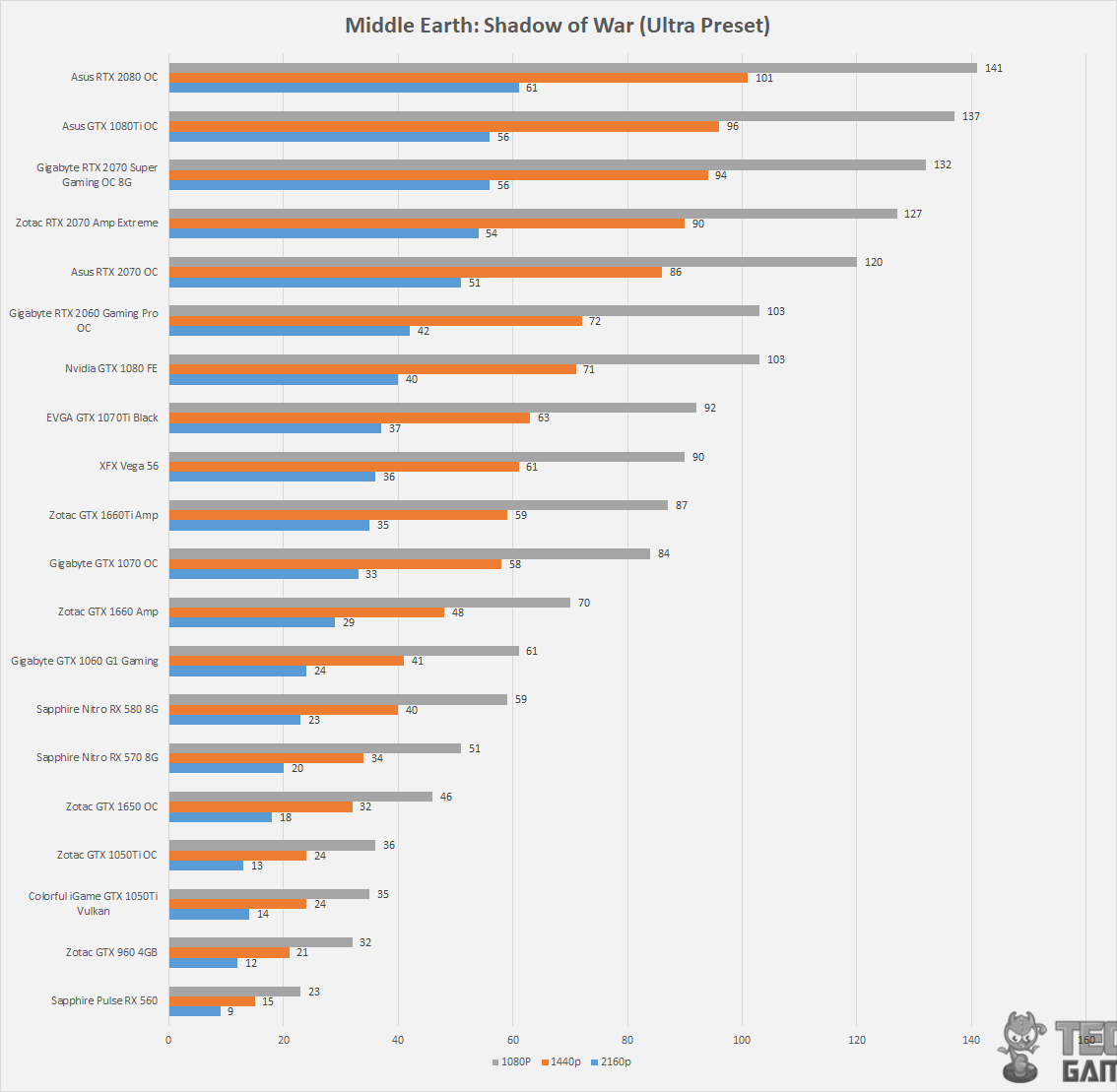 Up to 4% performance gain can be seen over the Zotac GeForce RTX 2070 Amp Extreme.
Up to 4% performance gain can be seen over the Zotac GeForce RTX 2070 Amp Extreme.
| Resolution | Performance Gain (%age) |
| 1080P | 3.93 |
| 1440P | 4.44 |
| 2160P | 3.70 |
The Witcher 3 DX11
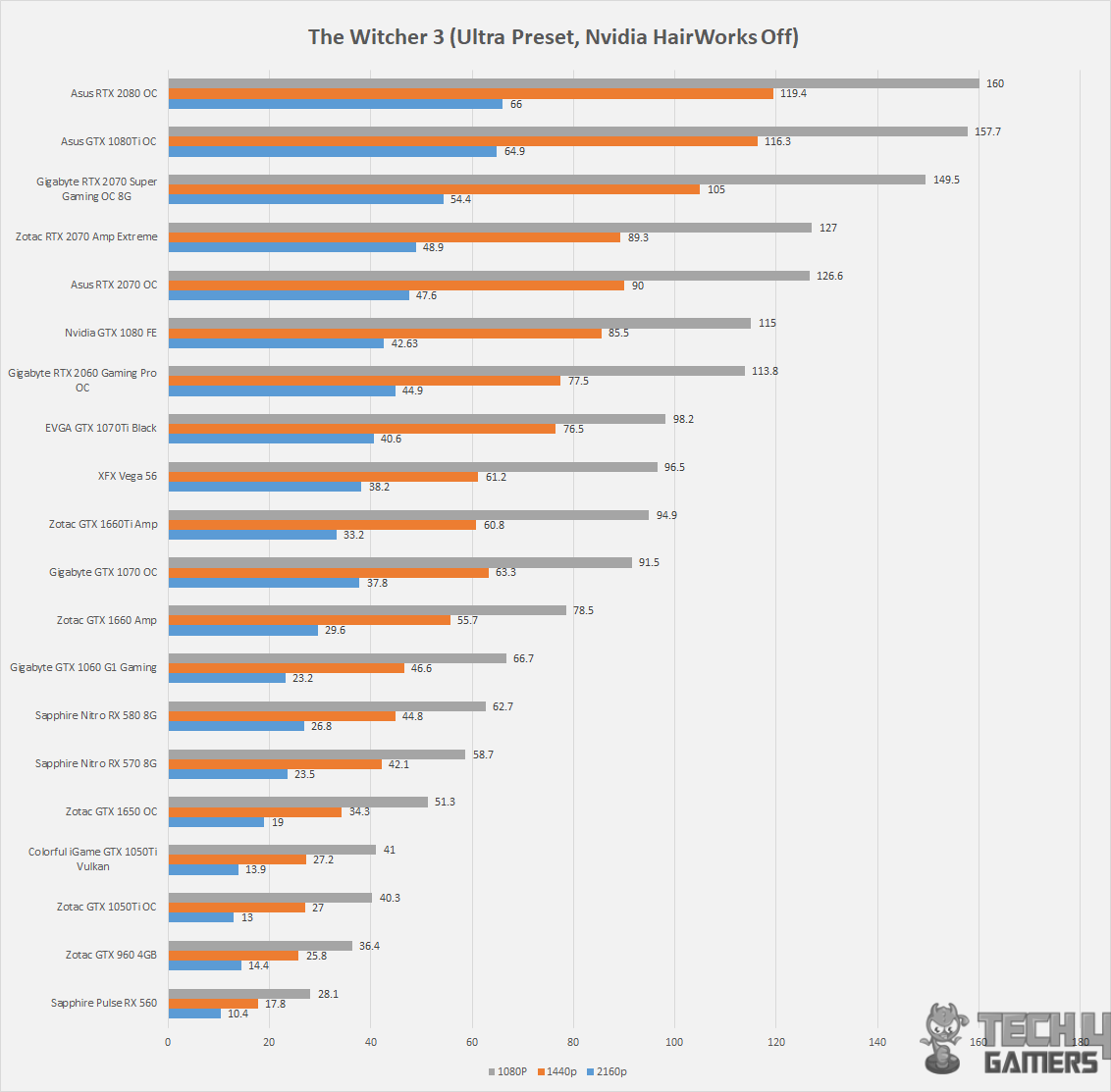 Up to 4% performance gain can be seen over the Zotac GeForce RTX 2070 Amp Extreme.
Up to 4% performance gain can be seen over the Zotac GeForce RTX 2070 Amp Extreme.
| Resolution | Performance Gain (%age) |
| 1080P | 17.71 |
| 1440P | 17.58 |
| 2160P | 11.24 |
This is the first game which has given a comparable performance boost. The game was tested thrice to validate the results.
In terms of the overall gaming performance, the Gigabyte GeForce RTX 2070 Super Gaming OC 8G has performed marginally well over the Zotac GeForce RTX 2070 Super Amp Extreme. In 1080p gaming, the overall gain is 4.50%. In 1440p gaming, the overall gain is 4.29%. In 2160p gaming, the overall gain is 4.60%. Overall, it is a 4.46% gain.
Ray Tracing and DLSS Benchmarks
Let’s start with the synthetic benchmarks.
The GIGABYTE GeForce RTX Super Gaming OC 8G has secured 6045 score which is just shy of 95 count from the Asus ROG Strix GeForce RTX 2080 OC.
3DMark has introduced DLSS feature test to measure the performance gain if any using the DLSS using the Port Royal benchmark. The test repeats itself without DLSS and with DLSS. The user can select from three resolutions.
On 1080p, there is a 42.42% improvement using the DLSS. The improvement at 1440p is 46.17%. The improvement is 94.70% at 4k.
Let’s take a look at the gaming benchmarks.
Battlefield V DXR
I turned on the Ray Tracing and performance hit was apparent in terms of the FPS. In Battlefield V, we can’t enable DLSS without enabling the Ray Tracing.
Turning the Ray Tracing on resulted in 40.18% performance hit on the 1080p. 40.58% hit was observed at 1440p. 49.24% was the performance hit on the 2160p.
Next step was to enable the DLSS and test the game again using Ray Tracing with DLSS and to check the percentage improvement. On 1080p, there was almost 12.95% improvement in the existing performance hit. 14.33% improvement was seen on 1440p. 34.21% improvement was seen on the 2160p. So far we have seen a marginal performance gain using the DLSS. Hopefully, with further drivers optimization, the performance will be further improved.
Metro Exodus DXR
I have tested the game with Ray Tracing set to Ultra with and without DLSS to have some numbers for the factual representation of what is going on with the Ray Tracing and at various quality settings. The graph is self-explanatory, to be honest as it is obvious that gaming with Ray Tracing has a performance hit. DLSS is definitely making up for the gap that is coming due to the performance hit.
Final Fantasy XV DLSS
Final Fantasy XV is one game that has DLSS settings at the user’s disposal to test in the game. Same is also available in the Benchmark utility.
Following settings were used for the benching on DLSS. The game was benched on same custom settings with and without DLSS for the results.
With DLSS we are seeing approximately 26.45% performance improvement.
Shadow of the Tomb Raider
Shadow of the Tomb Raider also has DLSS feature at the user’s disposal.
Boost Clocks
Now that we have taken a look at the gaming and synthetic benchmark results, it is time to take a look at the maximum boost clocks.
The Gigabyte GeForce RTX 2070 Super Gaming OC 8G has boosted to 1995MHz out of the box without any tweaking. However, I have observed that clocks have more fluctuations or variations than the other RTX cards which I have tested. Like the lowest dip was 1820MHz. The temperature at that time was approximately 64°C during Witcher 3 gameplay session at 4k. It can’t be coincident that three different drivers gave similar results!
Overclocking, Power Consumption and Thermals
For overclocking, the MSI Afterburner was used. I started with overclocking the VRAM. The voltage slide was set at 100%. I was able to push the memory clock by another +1000MHz (1.0GHz). Next, I started with the core clock overclocking. I met with no such good luck on the silicon as I was only able to push the core clock to +125MHz. The chip did reach 2145MHz but unfortunately, it was a failed attempt. 2070MHz is what was achieved with stable overclock.
Power Consumption
To measure the power draw, I am taking a different route as HWInfo64 shows the GPU Power and this is exactly what I have been showing on my graphs instead of overall system power draw. To monitor the maximum power draw, I am using The Witcher 3 4k run of 60 minutes and then record the reported maximum power draw from the HWInfo64. The PC was set to idle for like 15 minutes before the gaming session. This way any user can check their graphics card for power consumption easily.
This card like the other RTX graphics cards that I have tested were constantly hitting the power target. Even increasing the slider to 111% saw no effect. A little more headroom in terms of power target could have been beneficial.
Thermal Performance
I am not using Furmark or any other stress app for thermal performance checking. Instead, the reported temperatures are actually from the gaming session using The Witcher 3 at 4k resolution for a minimum of 60 minutes. MSI Afterburner is used to record the temperatures during the gaming session. The Gigabyte GeForce RTX 2070 Super Gaming OC 8G was idling at 42°C. On stock clocks, it maxed to 69°C and with overclocking it maxed to 73°C.
Software
RGB Fusion
Gigabyte has provided RGB LED lighting solution on their GeForce RTX 2070 Super Gaming OC 8G. The lighting effects could be controlled using their RGB Fusion 2.0 app. Following lighting modes are available on this graphics card:
- Cycle
- Static Color
- Flash
- Double Flash
- Breathing
- Intelligent
- Off
When the app was loaded it picked the CORSAIR Vengeance RG Pro DDR4 kit and I was able to change the lighting modes on the CORSAIR kit. Kudos to the Gigabyte!
The app has a user-friendly interface. The user can click on already listed lighting modes. Colors can be selected from the color spectrum or define the RGB or Hexa values.
Aorus Engine
Aorus Engine is the name of the utility app that can be used to monitor and control Gigabyte graphics cards. The application has a user friendly interface.
On loading the application, the available profiles are shown on the main page. The user can select an appropriate profile to load the corresponding settings. It is like a one-click operation. The graphics card model will be shown on the top left side. Clicking on Semi Passive will load the corresponding fan speed profile. Clicking on the home button will load the default or main screen. All the important variables are listed in the main interface like Boost Clock, Voltage, Fan Control, Temperature, and Power Limit.
Clicking the Auto Scan for the Boost clock will load another window. The software will try to determine the best possible boost clock based on the voltage level. It will take some time so sit back and relax. Once done. Click on the Apply button to load the effects.
The software allows the user to monitor the important parameters of the graphics card in real life. Clicking on Monitoring button will load another screen with the graph plots showing various variables like Core Clock, Memory Clock, GPU Temperature, etc.
Clicking on Edit will load the options window from where the user can select or choose which parameter to monitor.
Clicking on the Settings icon on the top right side will load another window with the software related options like setting to automatically start the utility app when windows start and to start is minimized etc.
Conclusion
Nvidia is still not yet done with the Turing architecture as they have now released the Super versions of the RTX series cards. Though this is not a surprising move as AMD announced their Navi based graphics cards followed by the release of RX 5700/XT graphics cards. Nvidia responded by launching the Super version of the RTX 2060 and RTX 2070 with improved efficiency, more shader units (more on it later), and most important of all the pricing. They released the Super line at the base price of the RTX 2070 and RTX 2060 and announced to decrease the pricing of current line RTX 2060 and RTX 2070. Price alone here is acting as a critical factor as performance is always a relative terminology and Nvidia for sure has done the trick again.
GIGABYTE sent us their GeForce RTX 2070 Super Gaming OC 8G for the review. The RTX 2070 Super is not based on TU106 as is the RTX 2070 (Non-S). Instead, it is based on TU104 the same chip which is powering the RTX 2080 (Non-S). This move makes sense as TU106 was already fully utilized leaving no room for tweaking. In TU104 Nvidia has had more room to play around by reducing the shader units and RTX Ops. Did it ring some bells? Here is a hint: GTX 1070Ti. Anyhow, I digress. The TU104 in RTX 2070 Super has 53 RTX Ops and 2560 shader units. Another important change is the presence of NVLink which is not present on the RTX 2070 (Non-S). Ouch! The GIGABYTE GeForce RTX 2070 Super Gaming OC 8G is based on TU104 GPU which is a cut-down version of the fully enabled TU104. It has 13600M transistors using 12nm technology having a die size of 545mm². This version of TU104 has 64 ROPs and 160 TMUs. We have 2560 shader units as compared to 2944 units on the GeForce RTX 2080. The Pixel fill rate is 116.2 GP/s and the Texture fill rate is 290.4 GT/s. GIGABYTE has used 8GB of GDDR6 VRAM from Micron rated at 14000 clocks using 256-bit bus width having a bandwidth of 448 GB/s. This card has 1x HDMI 2.0b port and 3x DP 1.4 ports as well as USB Type C port for VirtualLink. The card has 2.5 slot design having a dimension of 286.5×114.5×50.2mm (LxWxH). The maximum supported digital resolution is 7680×4320 @ 60Hz.
This graphics card has Gigabyte’s legendary and ever-popular WINDFORCE 3X cooling solution comprising 3x 82mm fans which spin in an alternate direction which according to Gigabyte is the only way to handle the turbulence that may come using all the fans spinning in the same direction. The airflow is spilt by the triangular fan edge, and guided smoothly through the 3D stripe curve on the fan surface, effectively enhancing the airflow. The 3D Active Fan provides semi-passive cooling, and the fans will remain off when the GPU is in a low load or low power game. The aluminum heatsink consists of three sinks which are interconnected using 6 composite heat-pipes which seem to be 8mm thick each. The critical areas like VRAM, GPU and MOSFETs have metal copper plate making direct contact with them. These plates come in contact with the aluminum heatsink using the thermal pads. The metallic backplate adds rigidity with pleasant aesthetics and there are thermal pads between the PCB and the backplate. The card takes power using 8-pin and 6-pin power connectors.
The Gigabyte GeForce RTX 2070 Super Gaming OC 8G has performed well though the overall performance boost over the RTX 2070 (Non-S) is roughly 5% approximately. In a few games, this boost ranged from 9% to 17% whereas there were some titles where the difference was like 1-2 FPS which hardly makes any difference. The card is listed at $549 (NewEgg price) at the time of the review. This is where this card makes more sense and brings value to your bucks. For the users of the regular GeForce RTX 2070 cards, stick to your cards as they are still powerful enough to drive your gaming needs though I can feel you as we missed out on NVLink on the regular GeForce RTX 2070. Same goes for the GTX 1080Ti users.
Gigabyte has cooperated with Nvidia and they are offering Call of Duty: Modern Warfare on purchase of their Gigabyte Aorus GeForce RTX 20/Super graphics cards with terms and conditions. This promotion is valid from 17-Sep-19 to 18-Nov-2019. For more information, click here.
I am thankful to Gigabyte for giving me the opportunity to review their GeForce RTX 2070 Super Gaming OC 8G graphics card.
Thank you! Please share your positive feedback. 🔋
How could we improve this post? Please Help us. 😔
[Hardware Reviewer & Editor]
Meet Nauman Siddique, a highly experienced computer science graduate with more than 15 years of knowledge in technology. Nauman is an expert in the field known for his deep understanding of computer hardware.
As a tech tester, insightful reviewer, and skilled hardware editor, Nauman carefully breaks down important parts like motherboards, graphics cards, processors, PC cases, CPU coolers, and more.
- 15+ years of PC Building Experience
- 10+ years of first-hand knowledge of technology
- 7+ years of doing in-depth testing of PC Hardware
- A motivated individual with a keen interest in tech testing from multiple angles.
- I majored in Computer Science with a Masters in Marketing
- Previously worked at eXputer, EnosTech, and Appuals.
Get In Touch: [email protected]


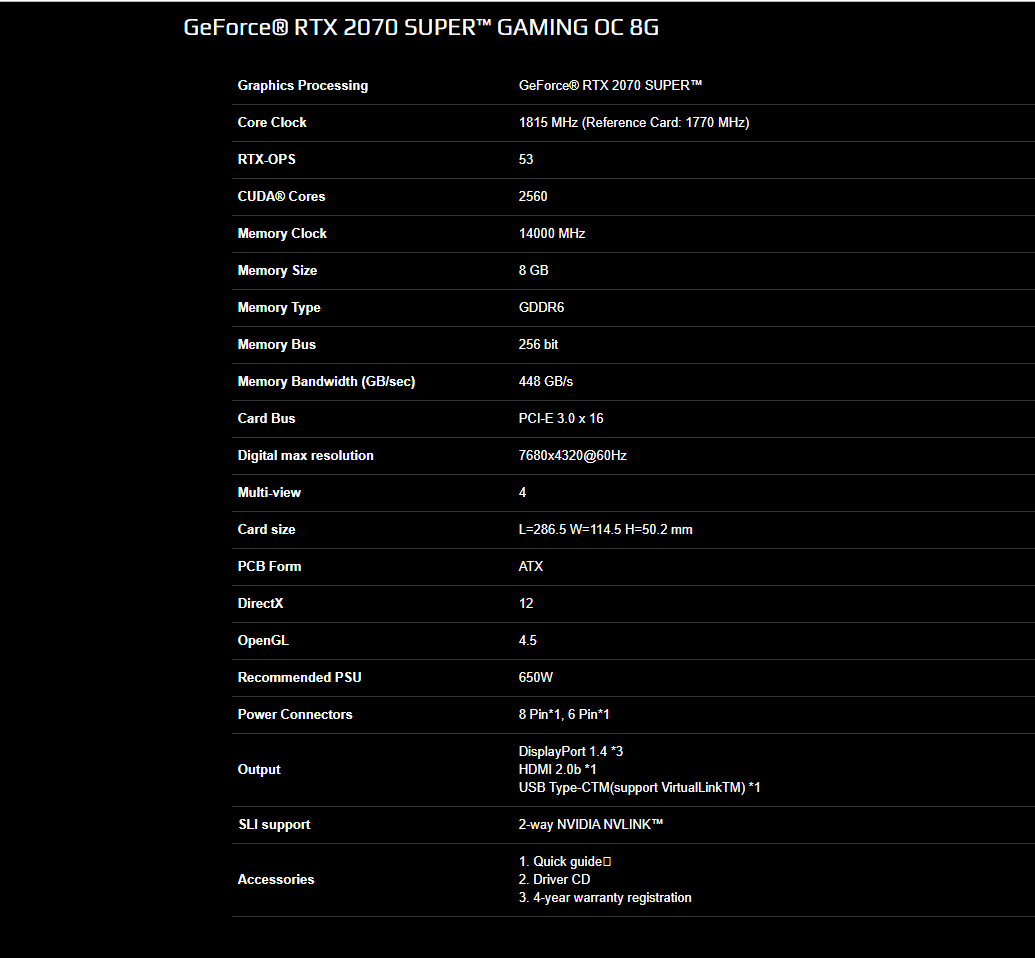
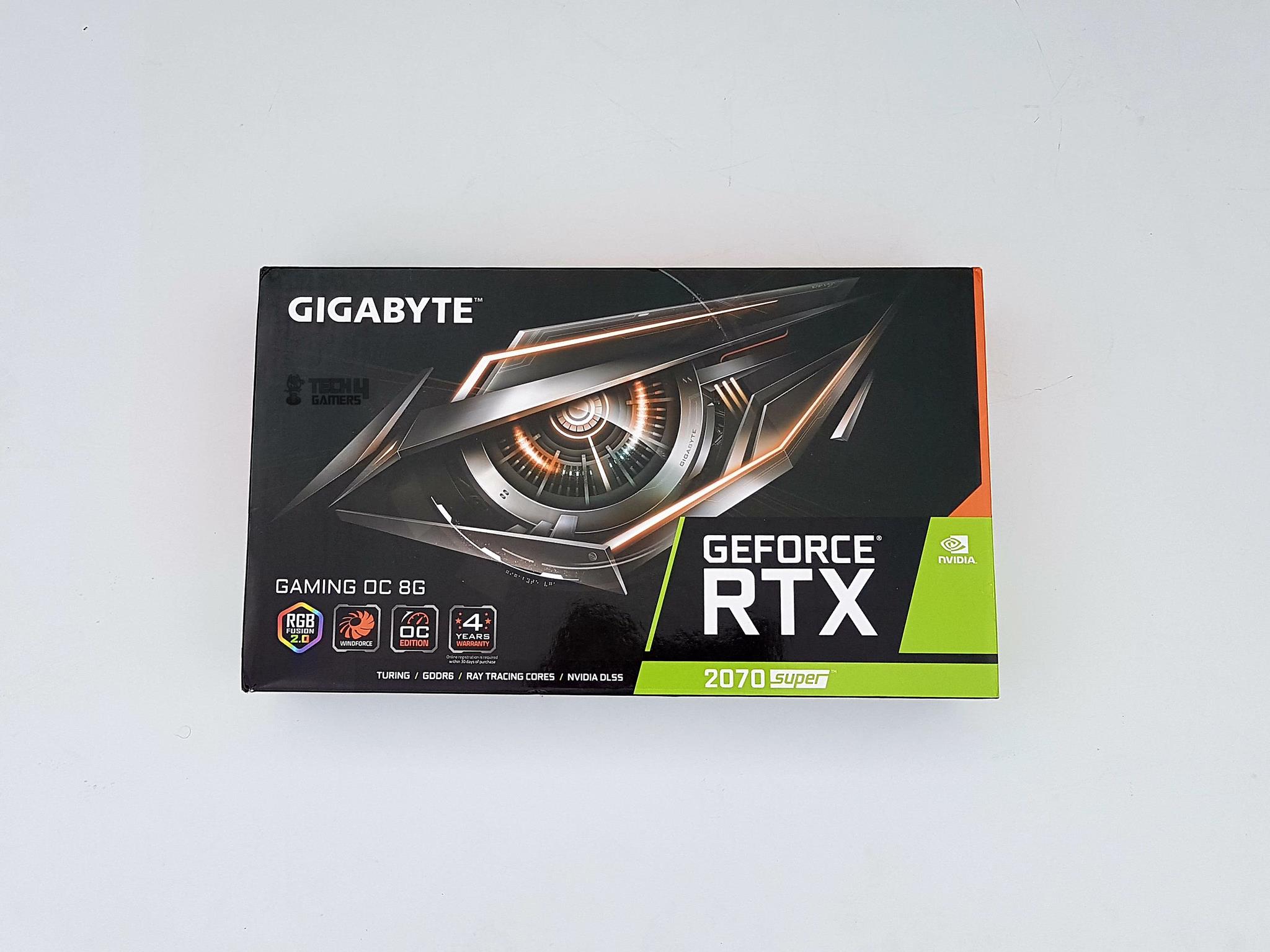
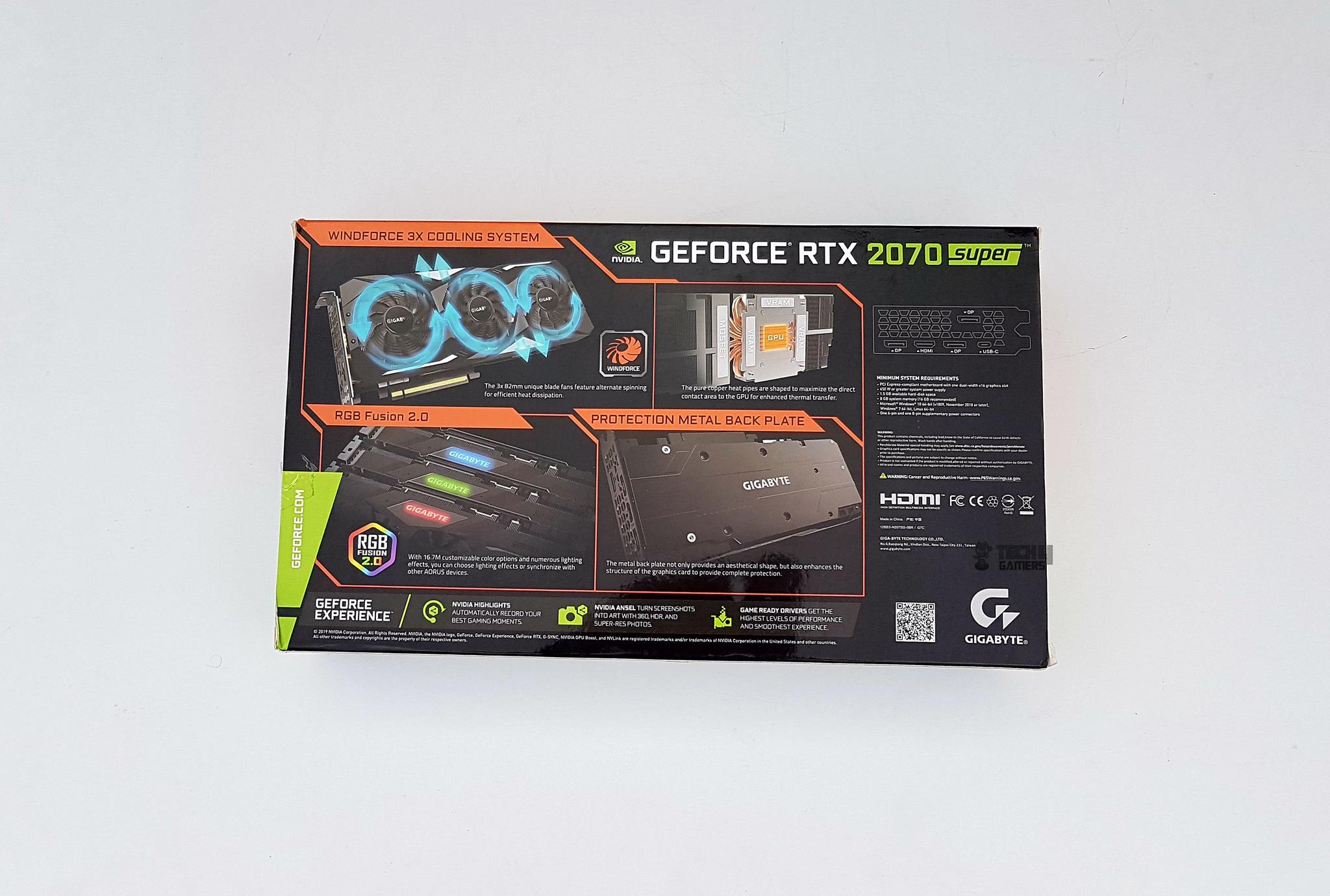
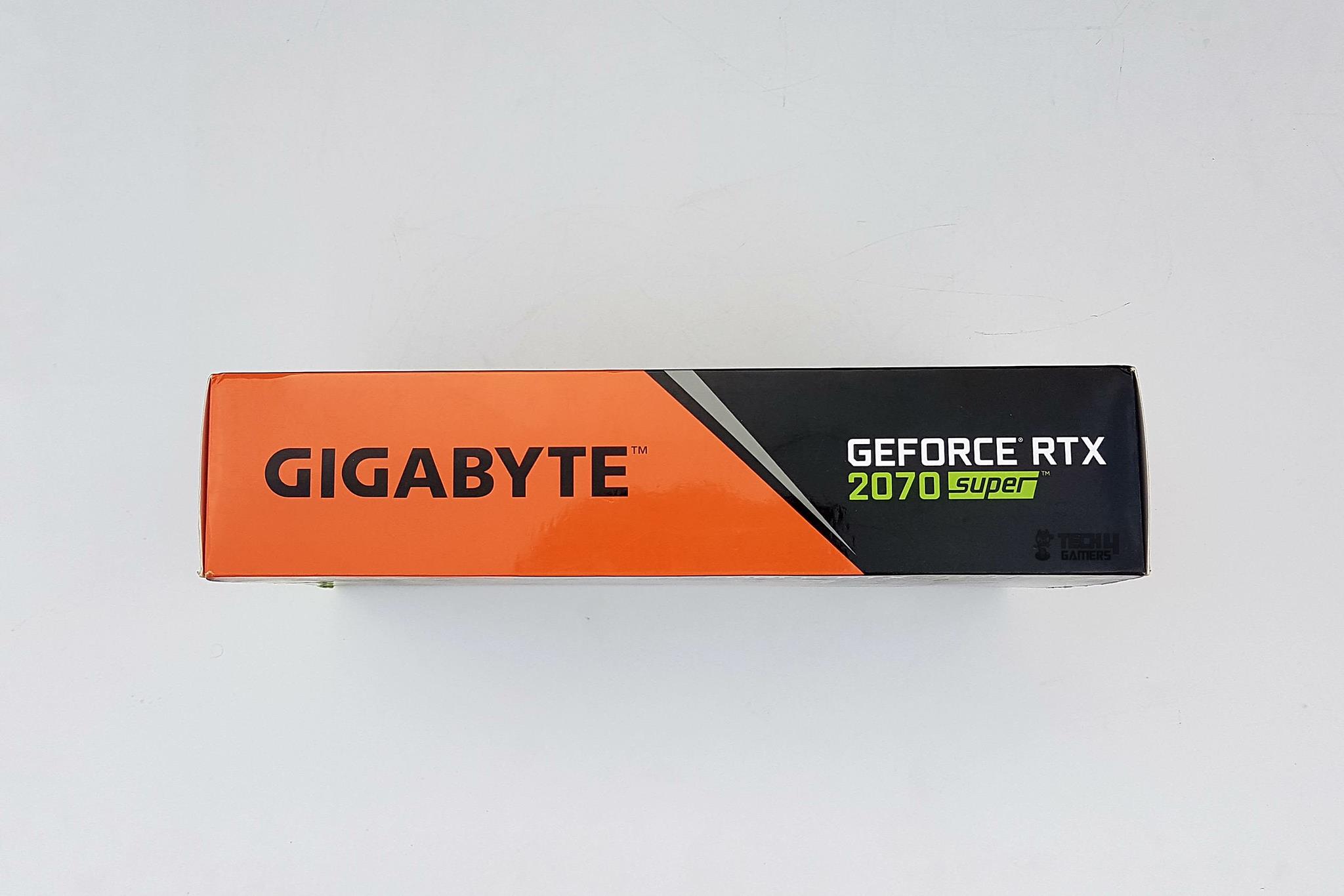
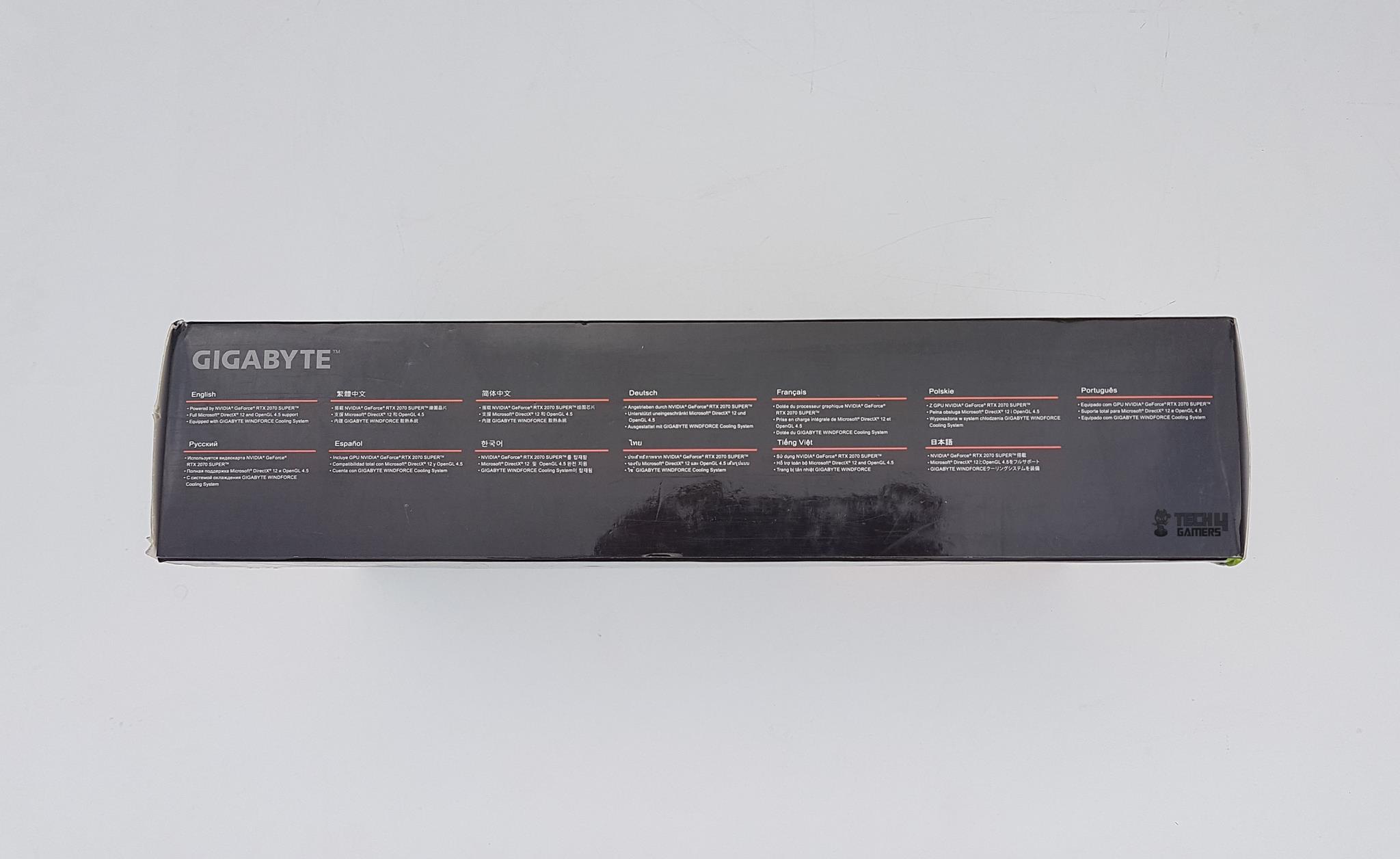
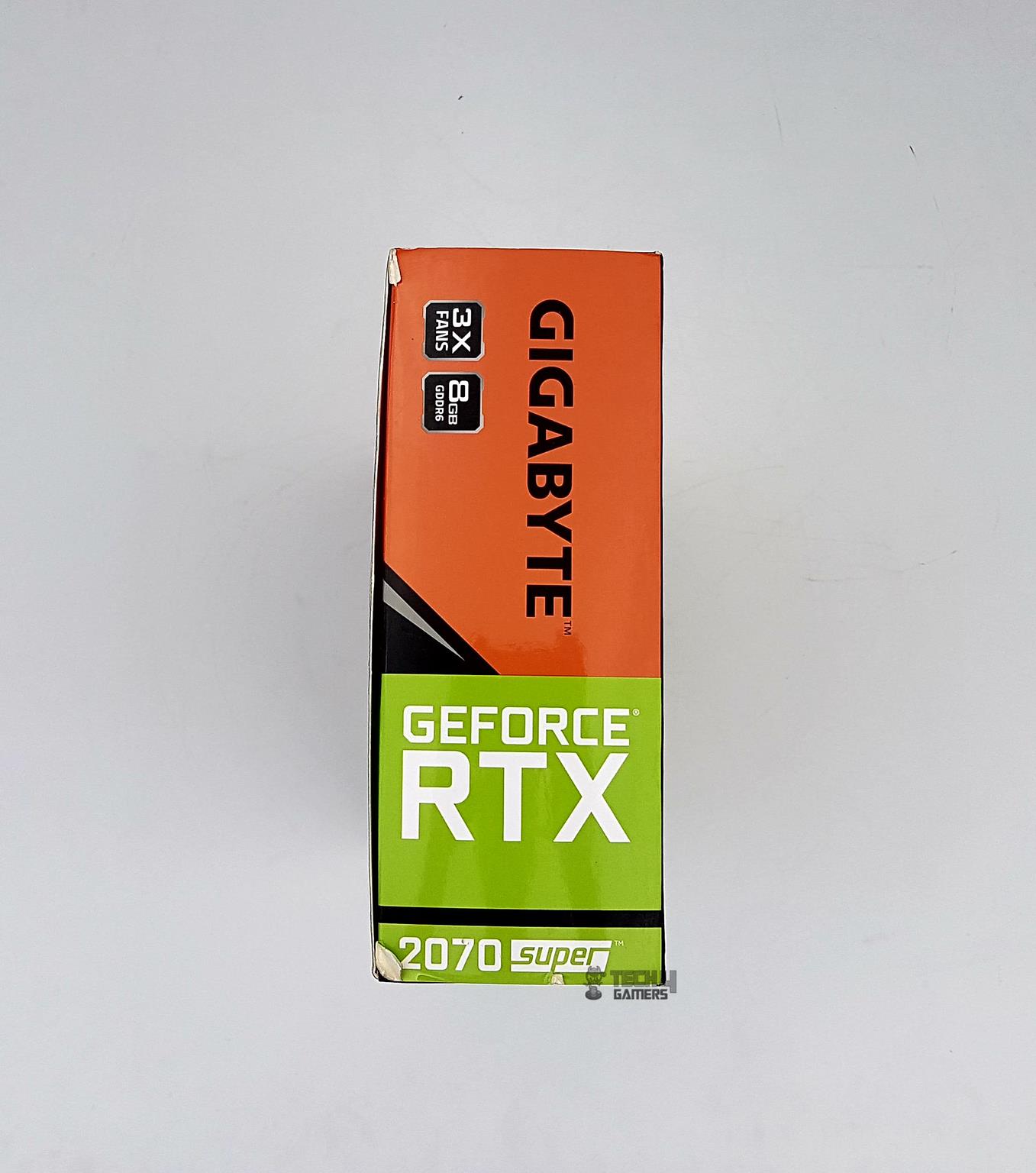
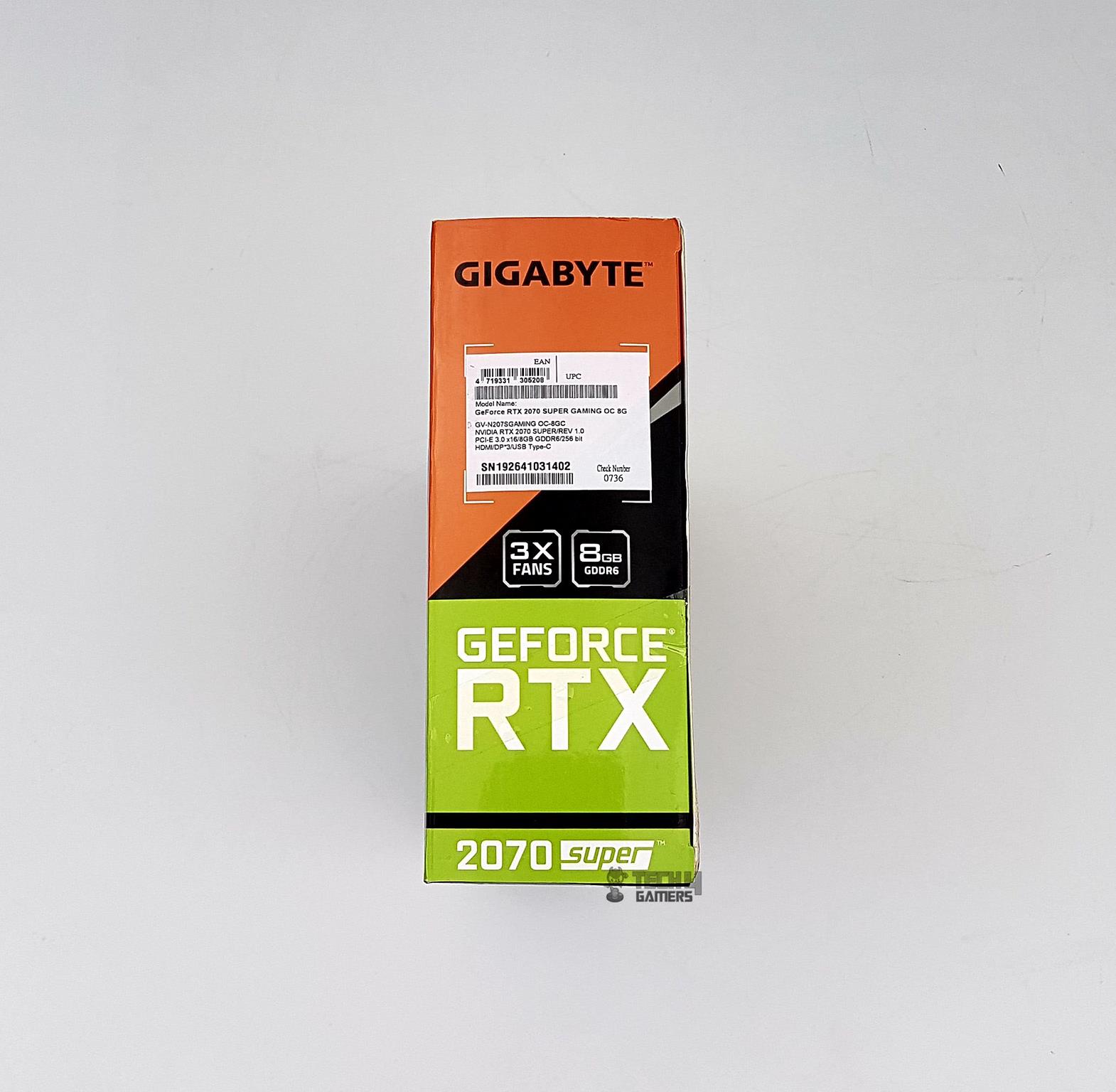

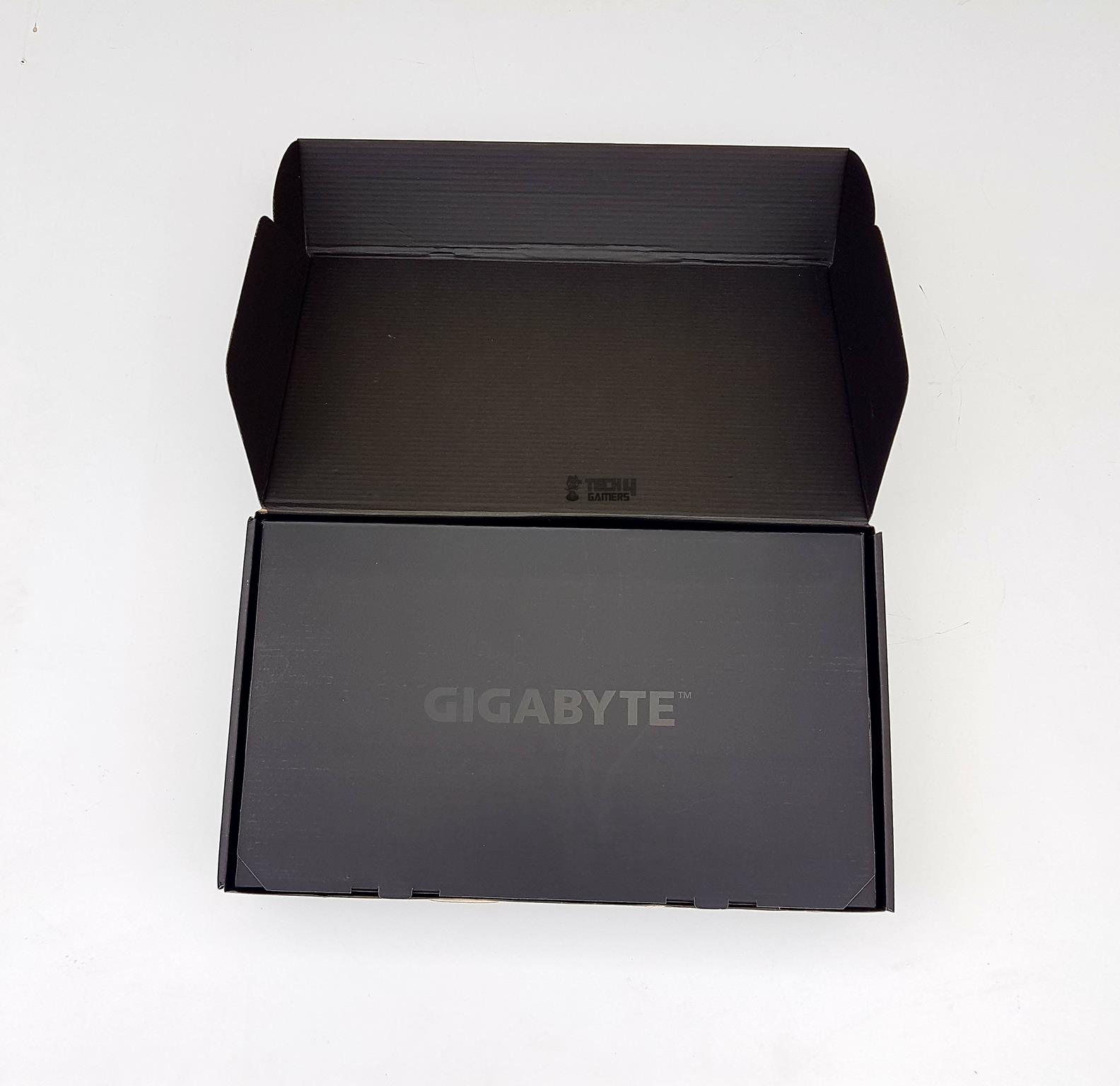
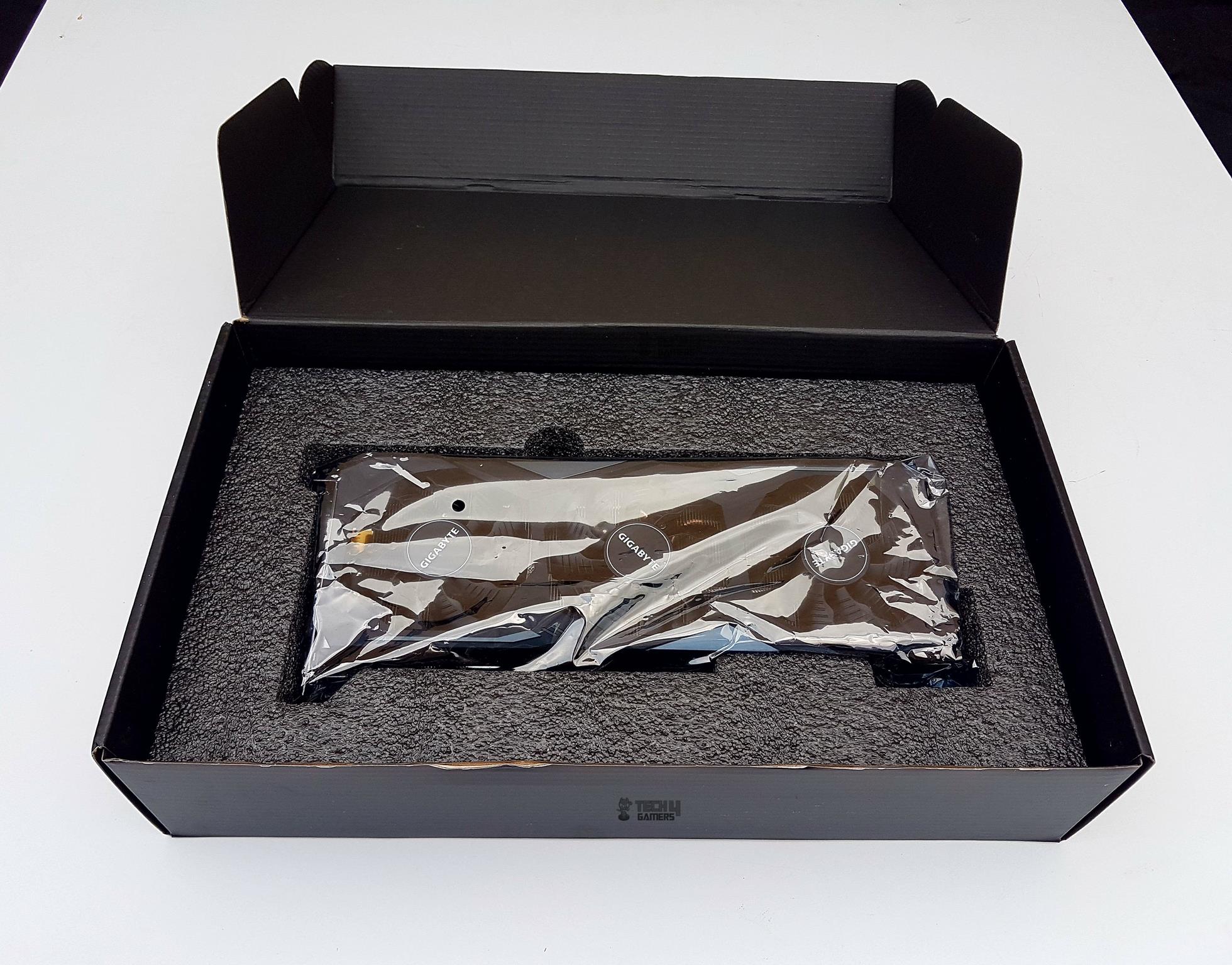
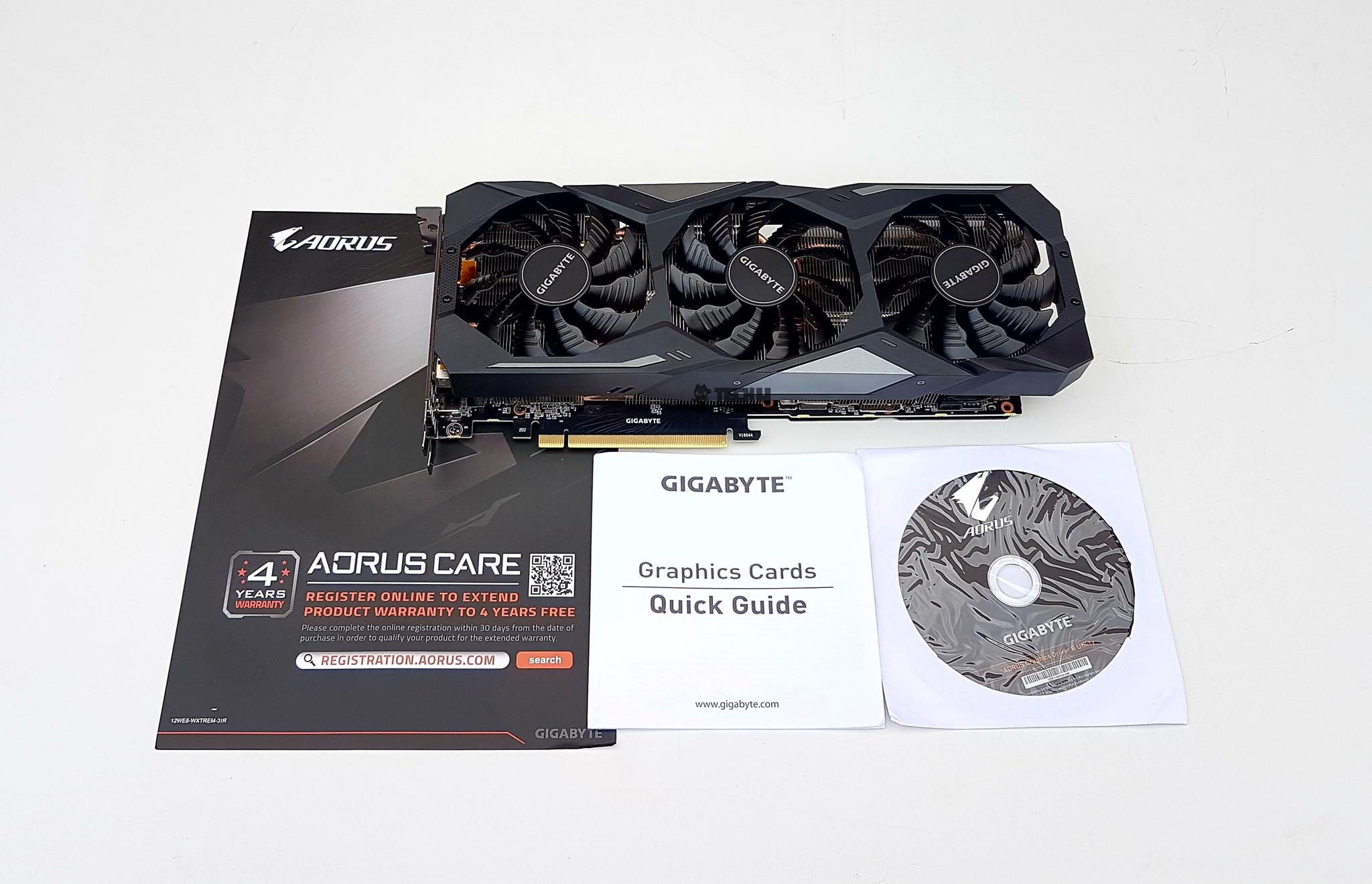

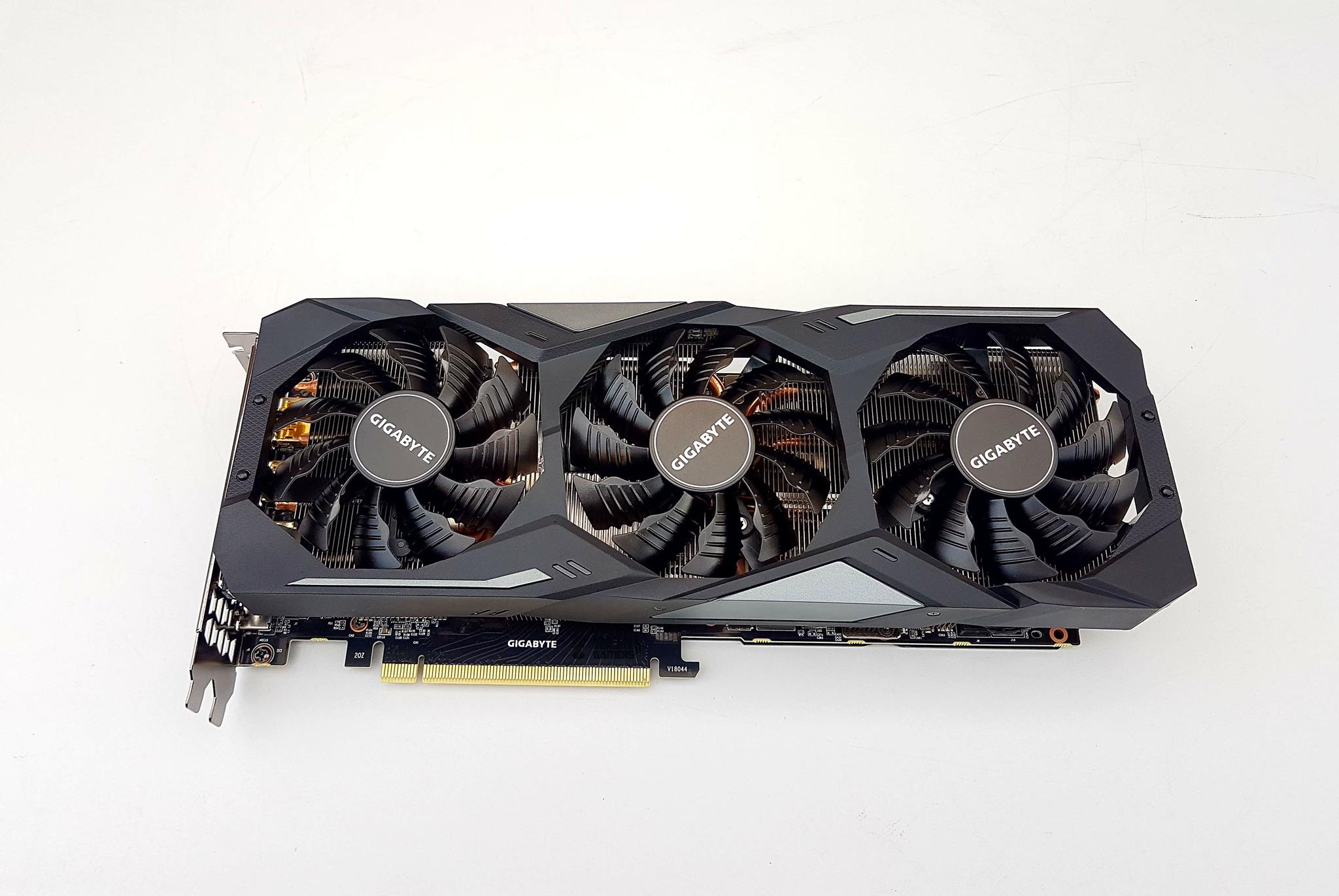




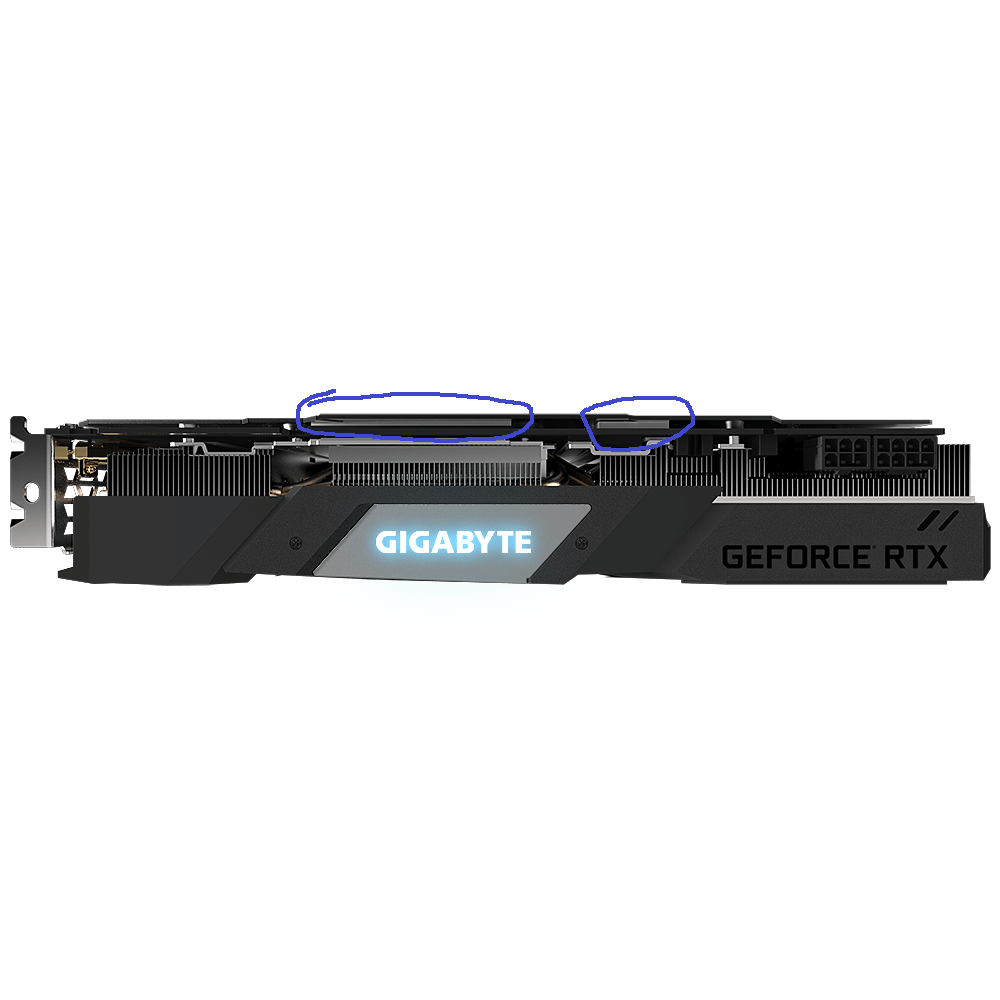


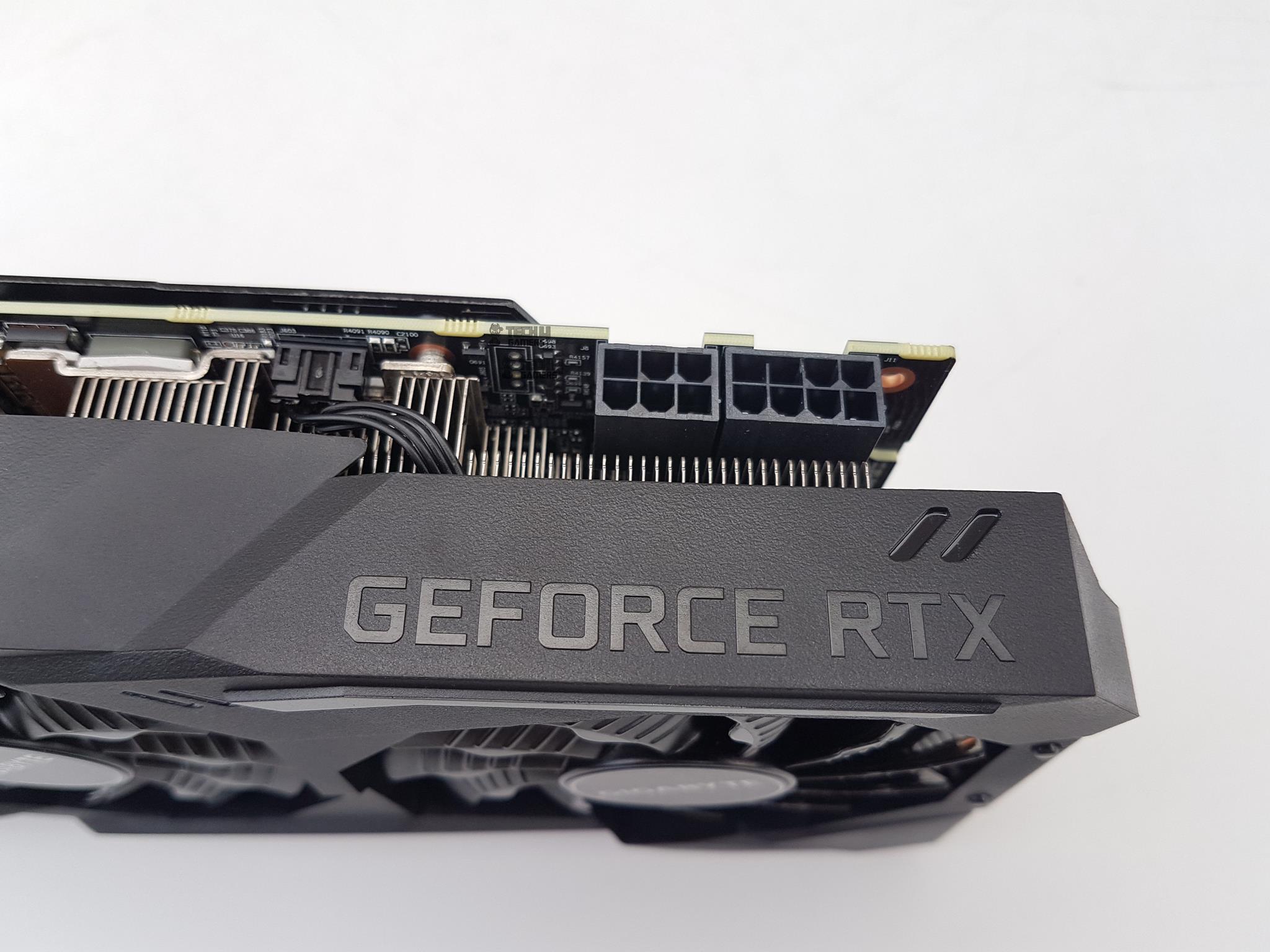
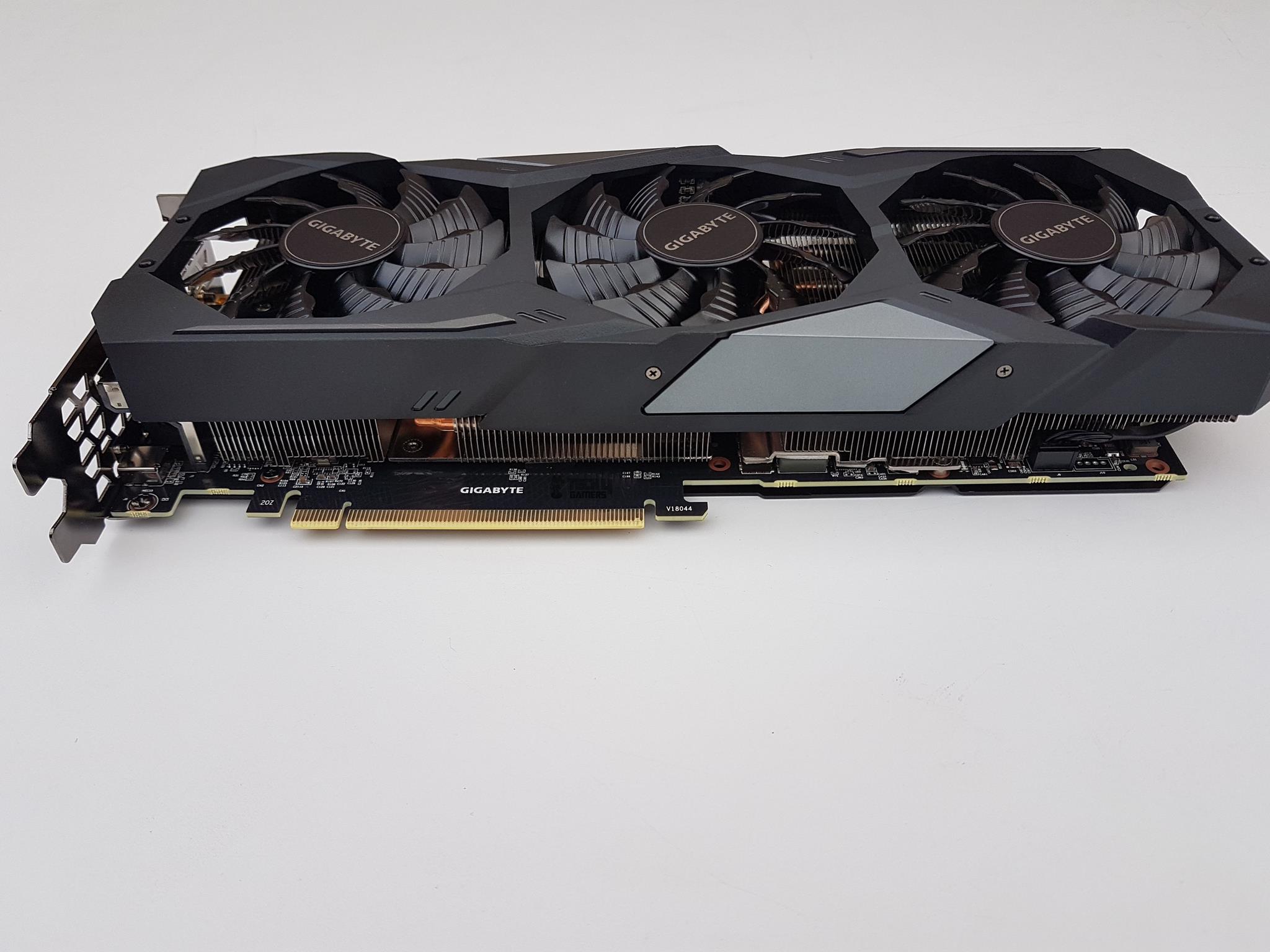

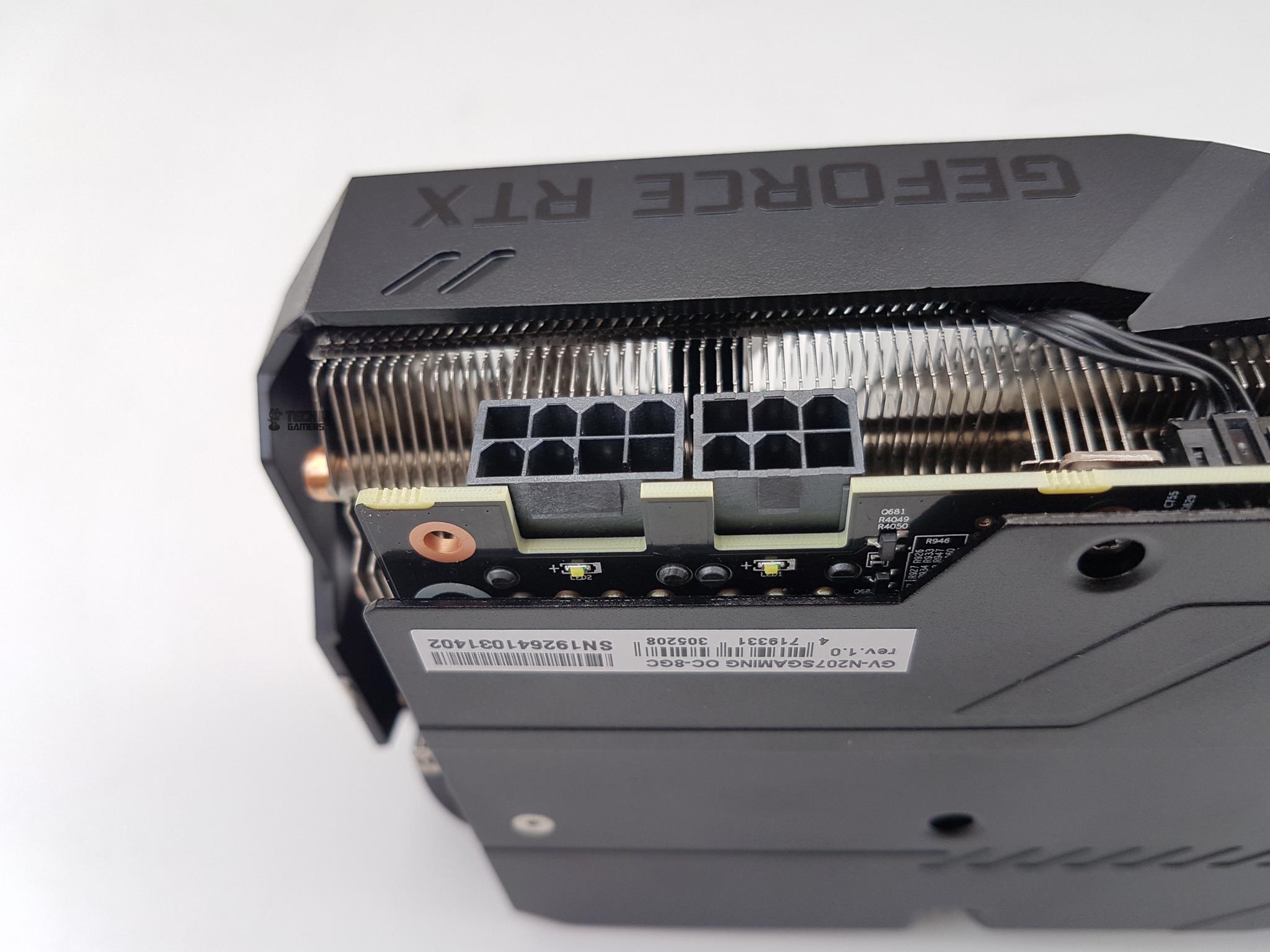
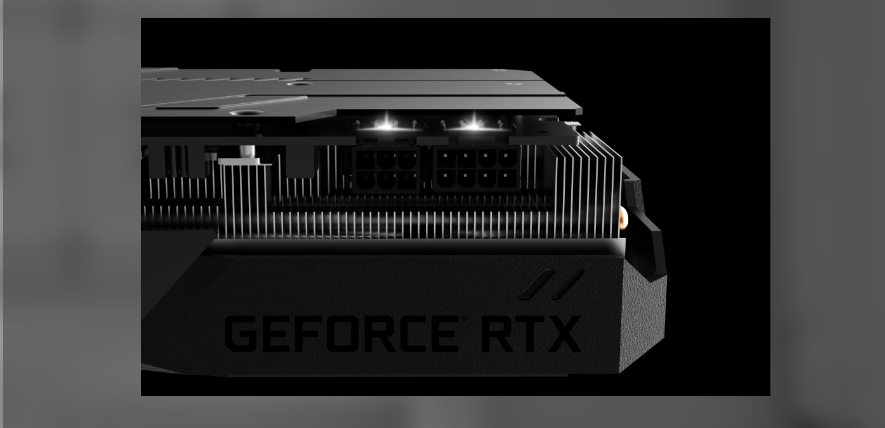
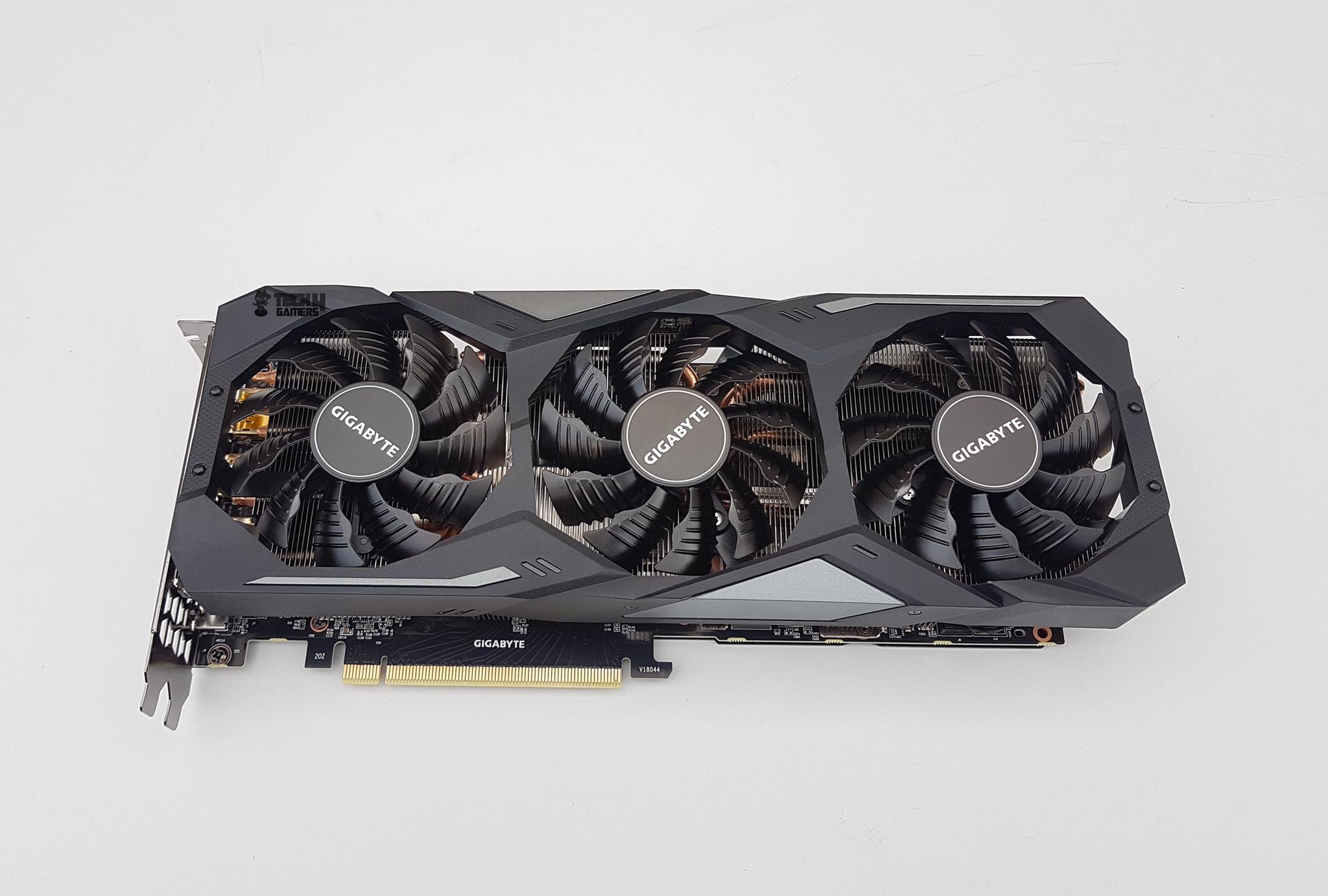
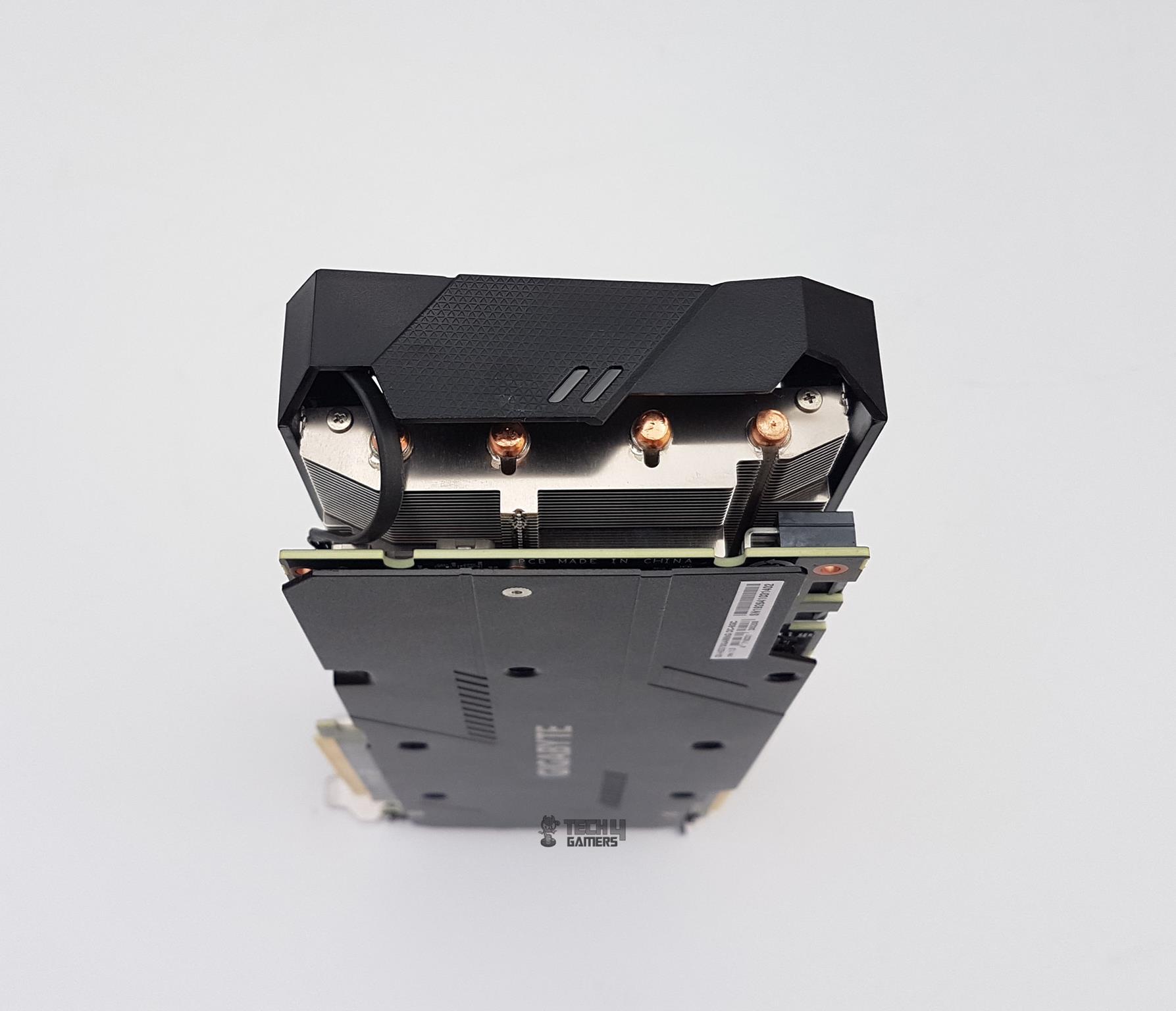
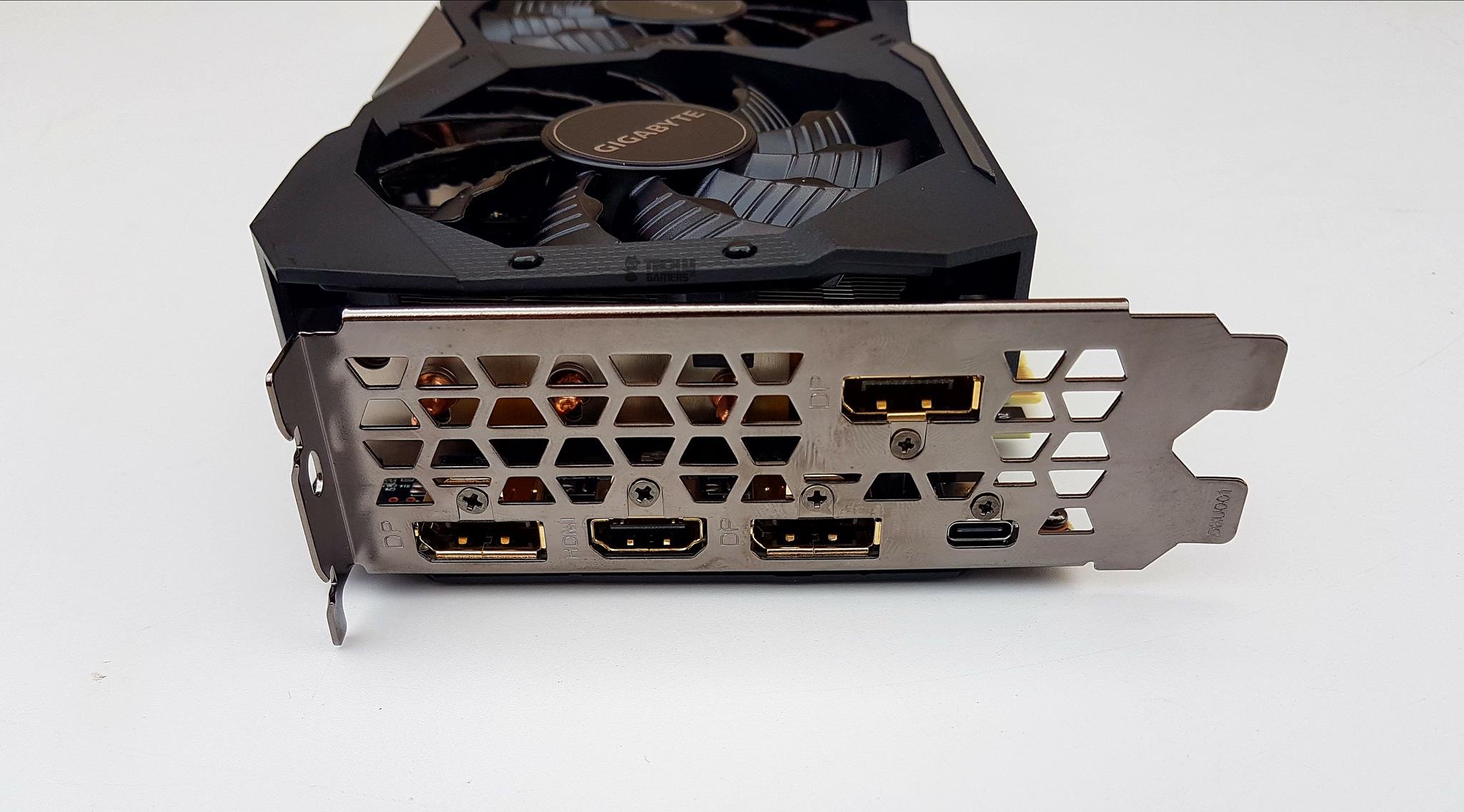



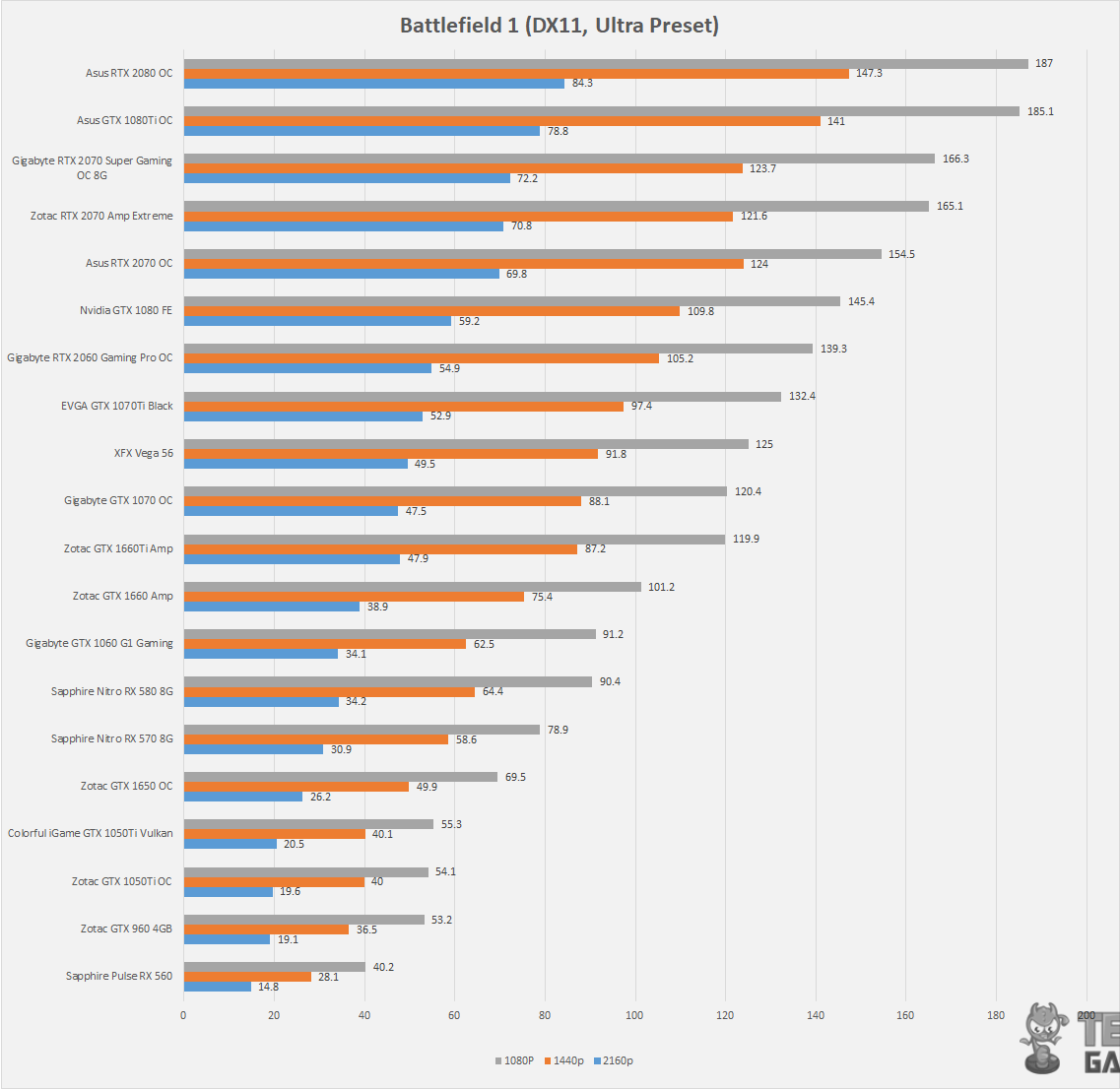

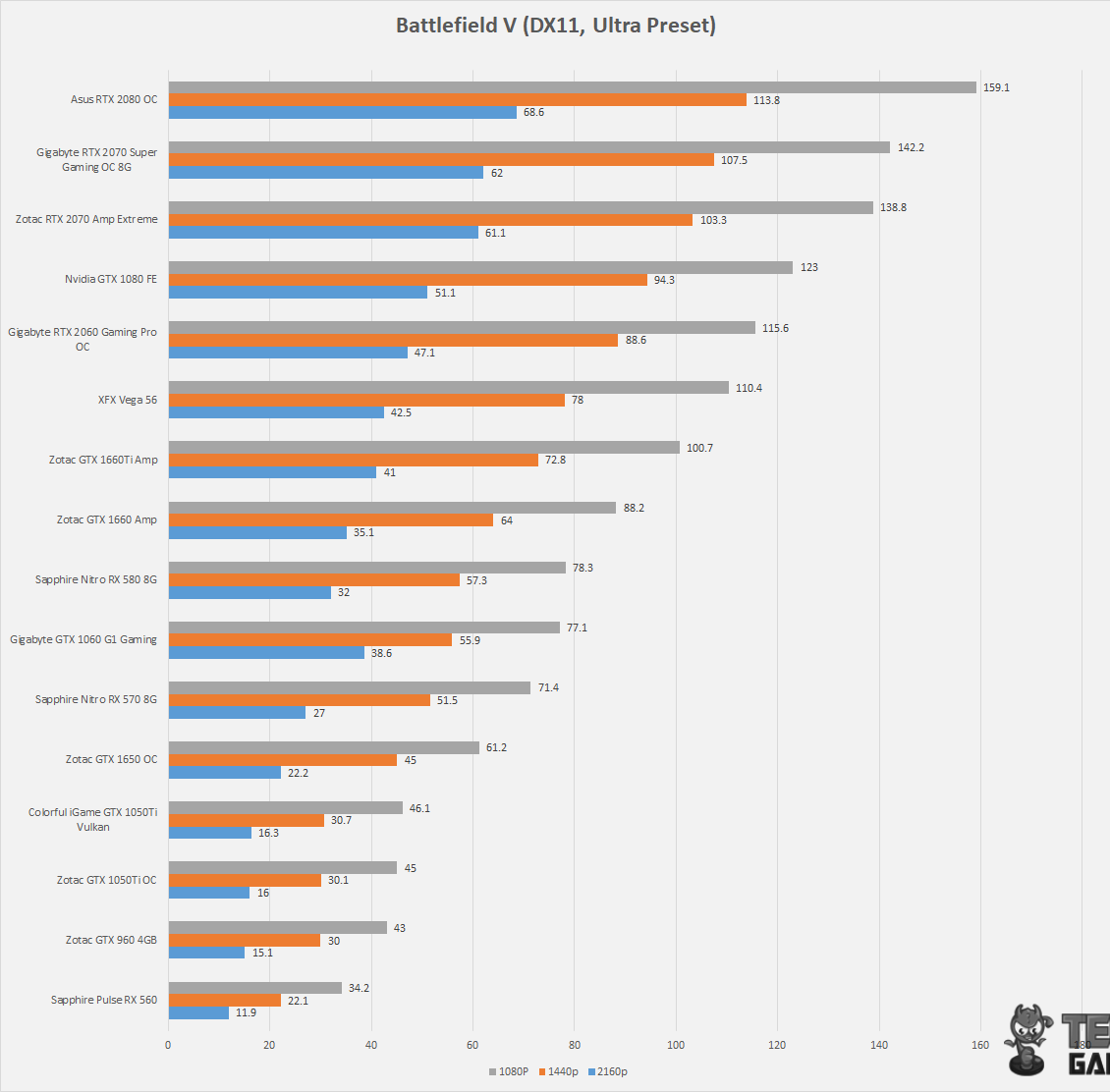
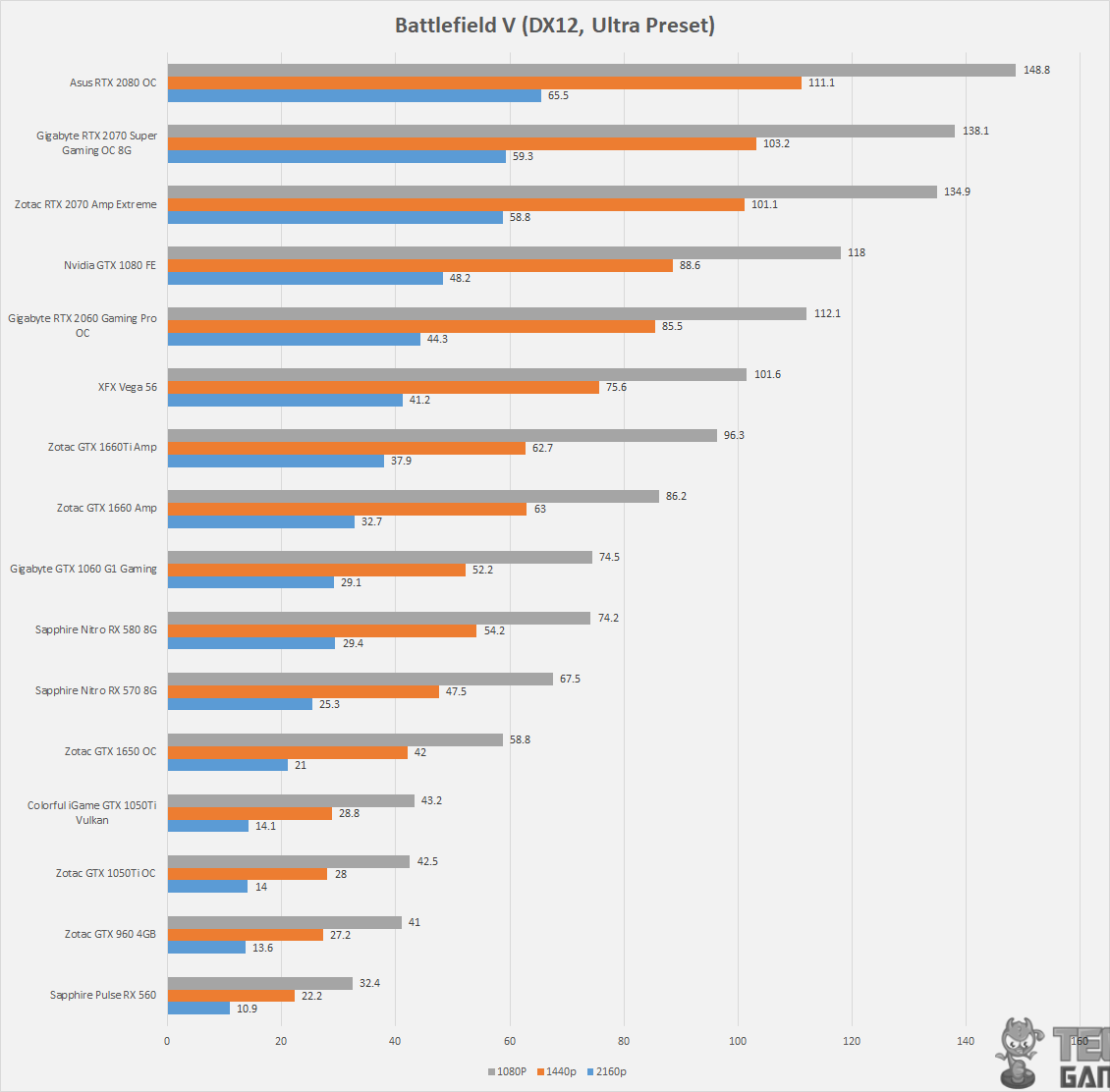
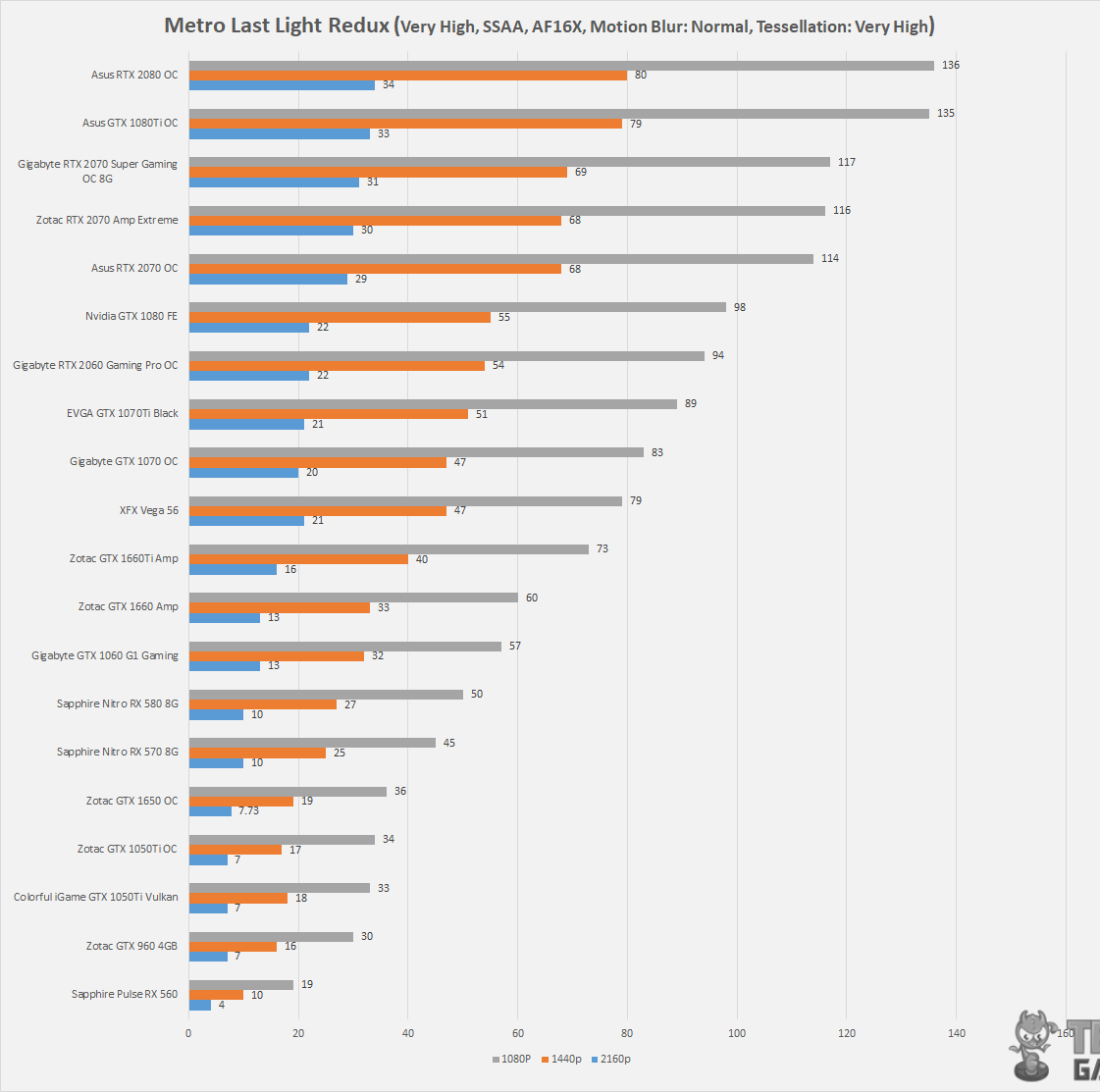

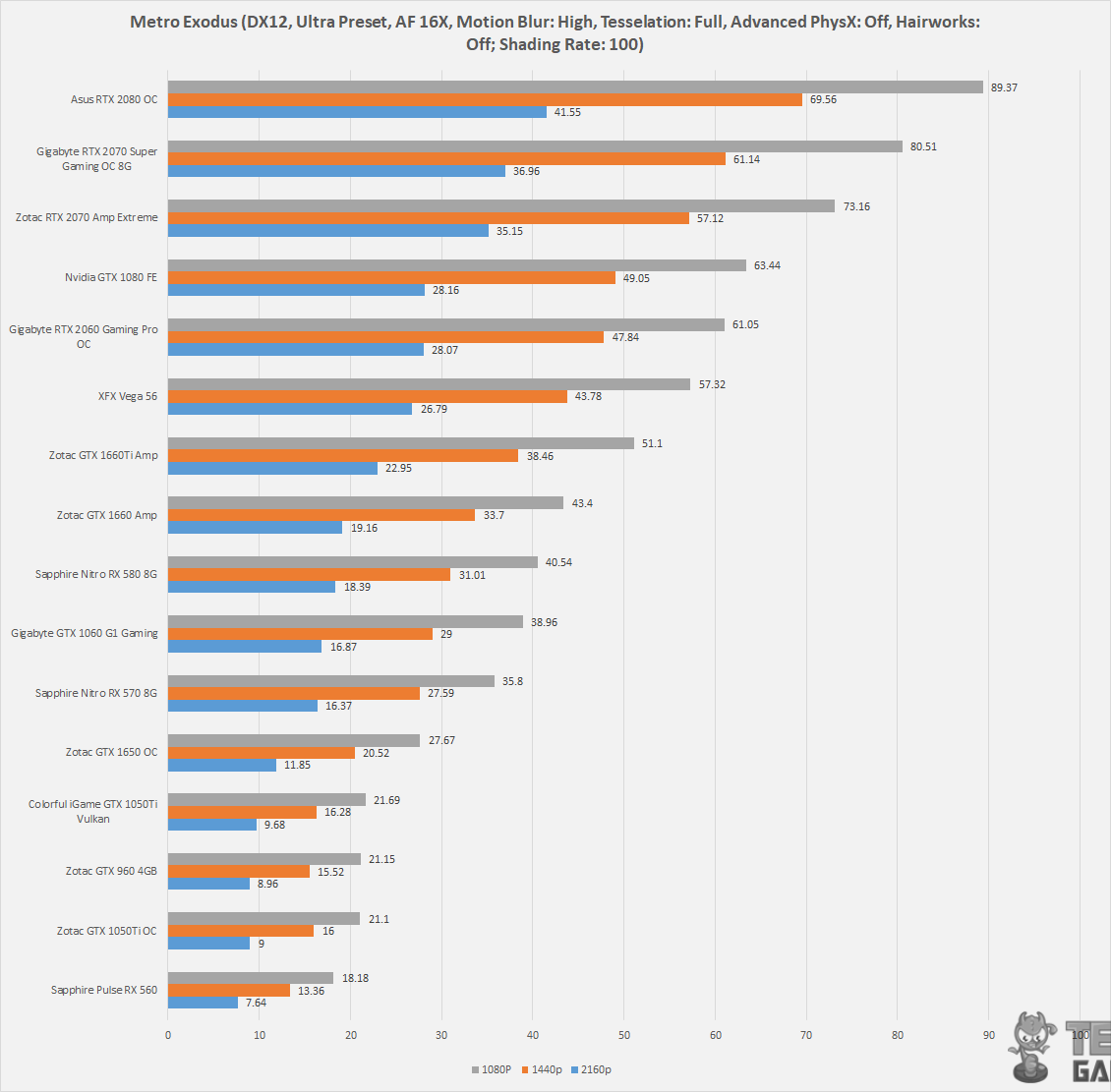
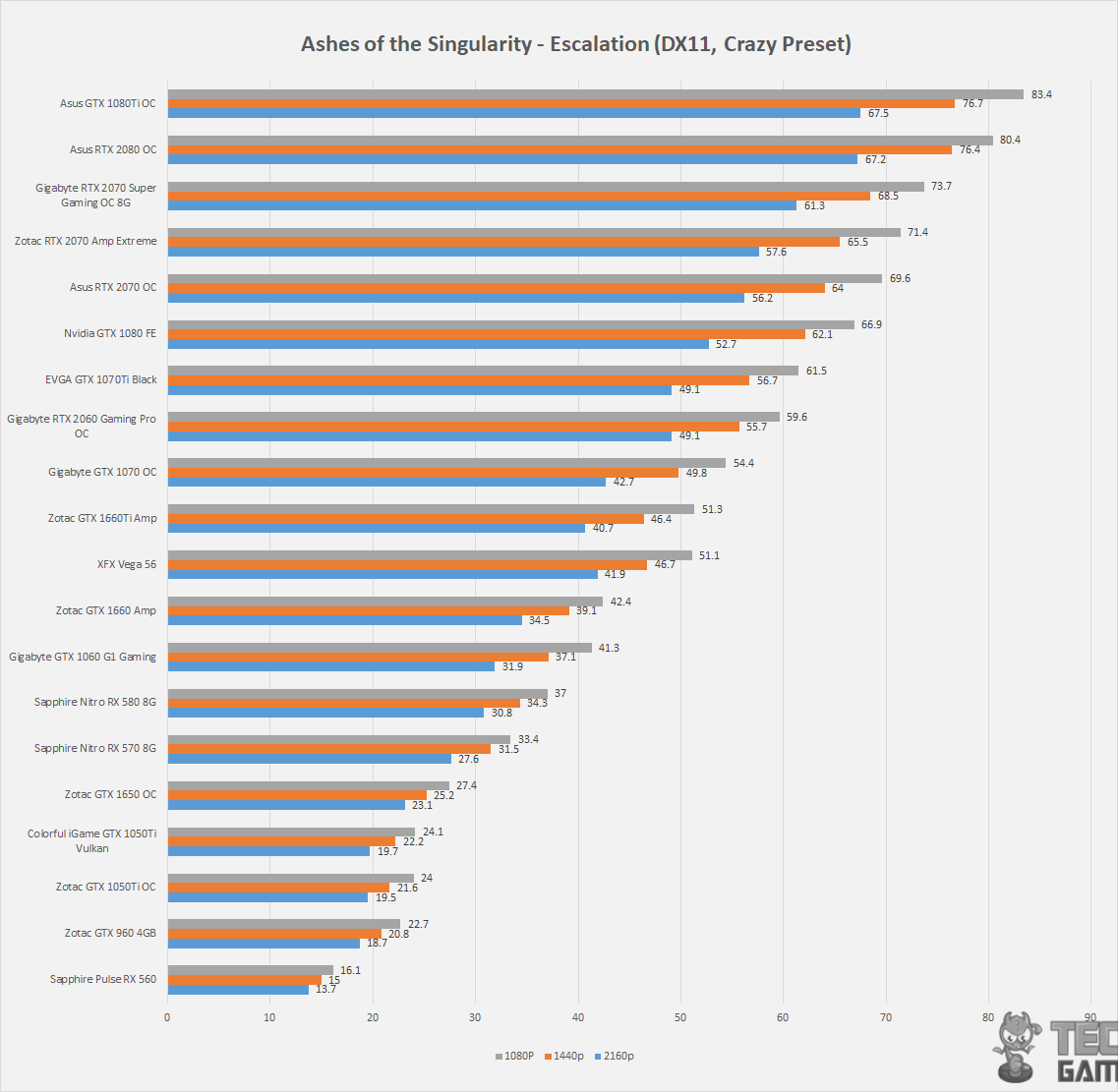
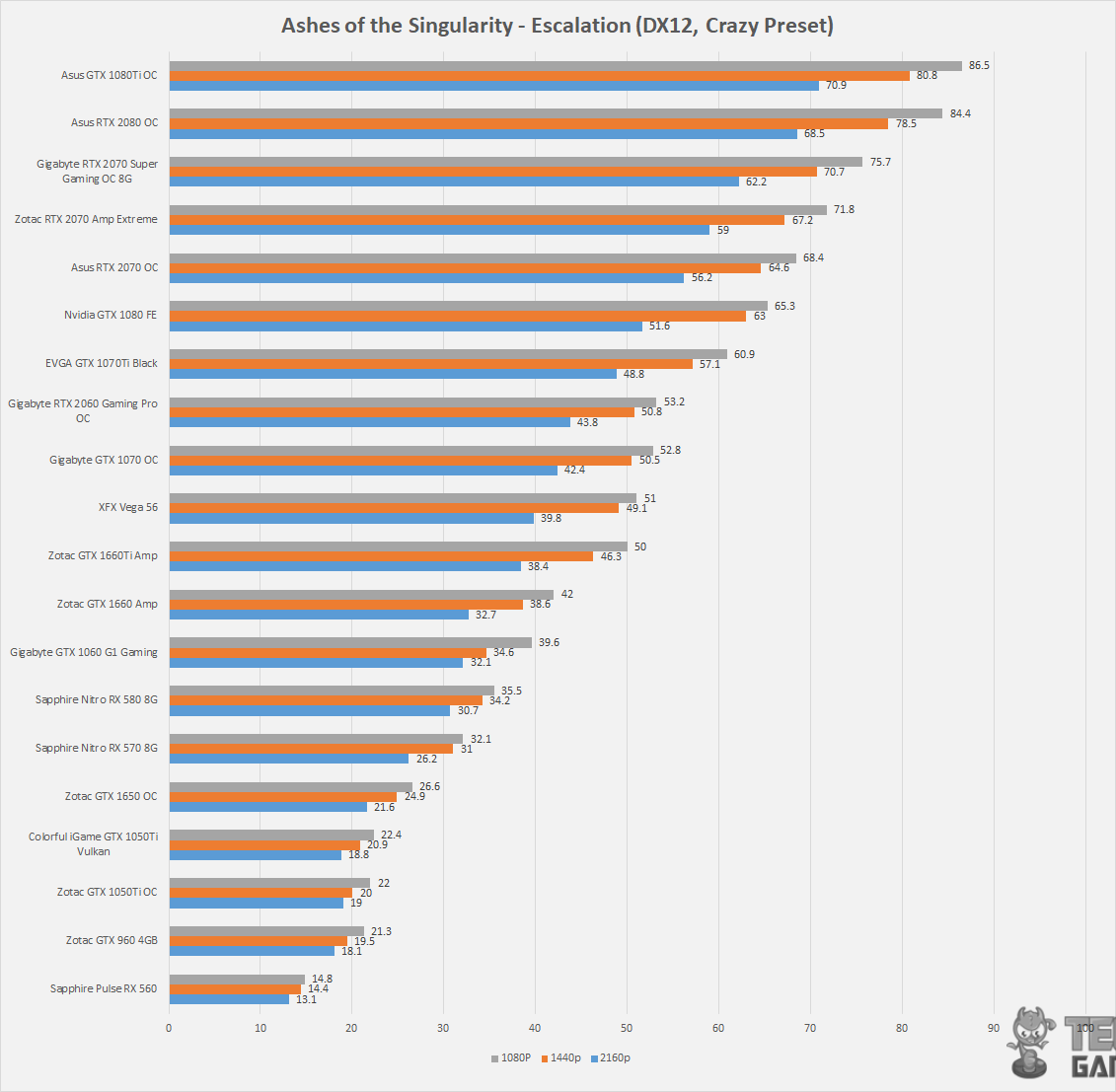
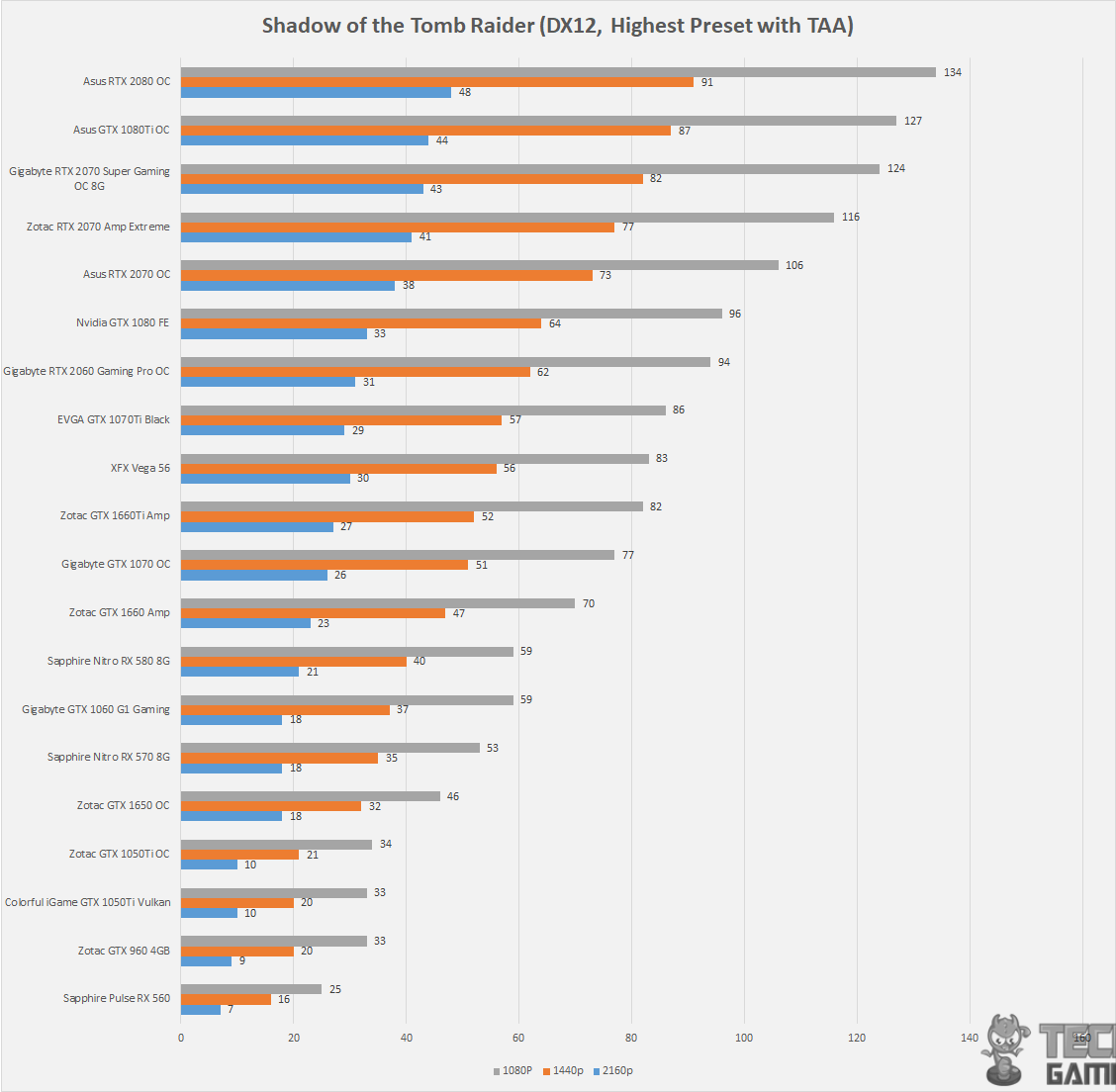

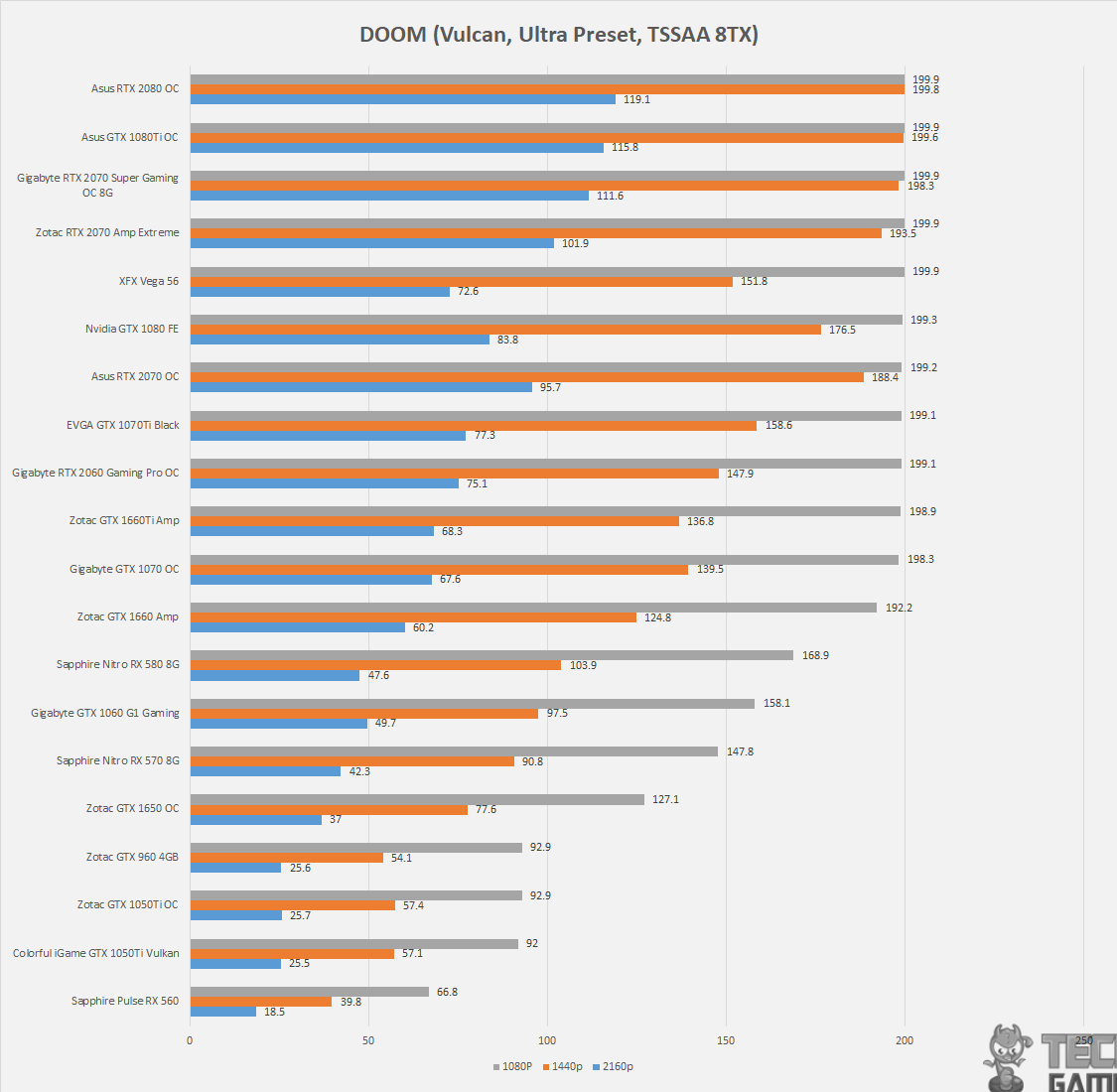
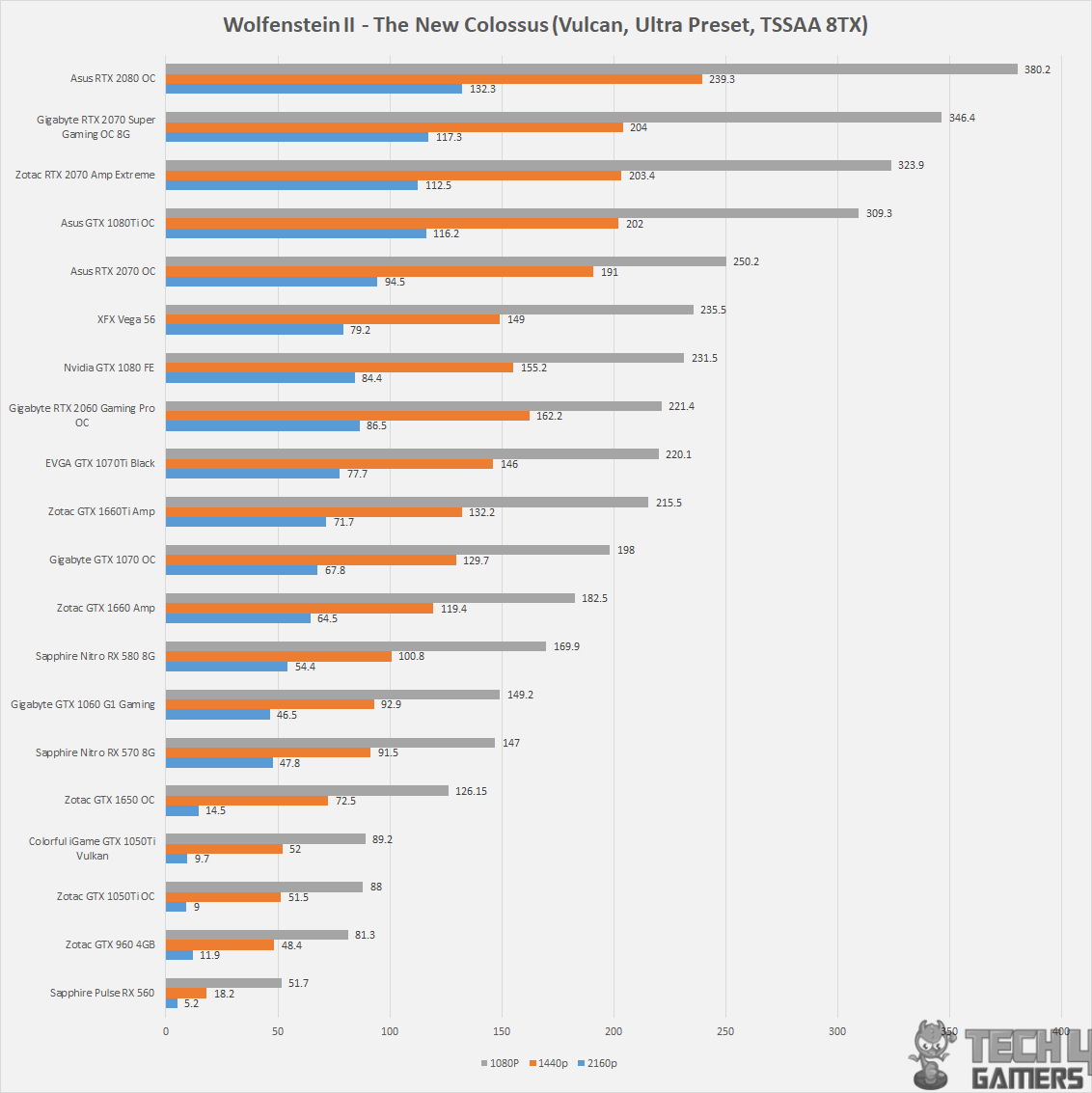
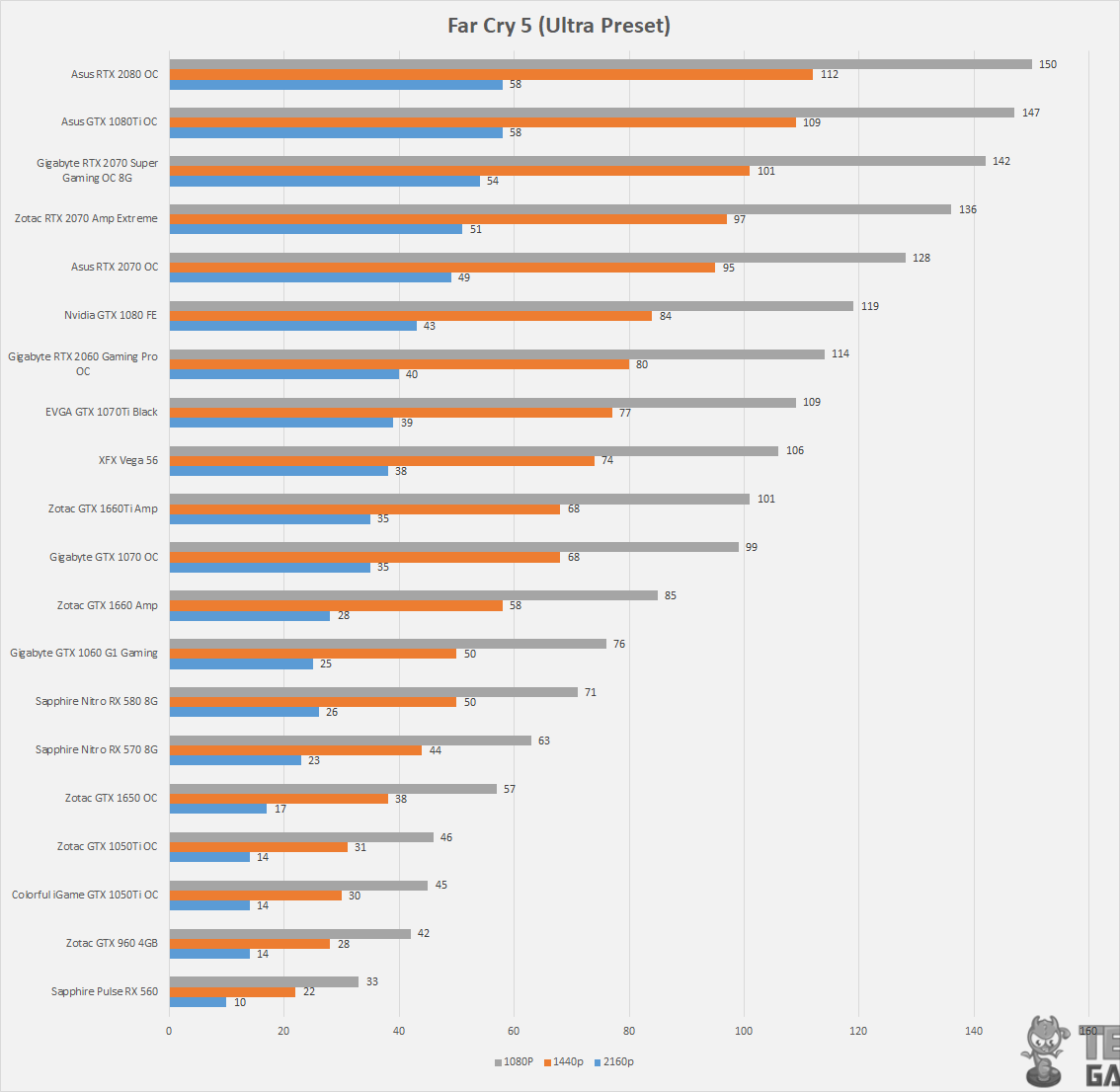
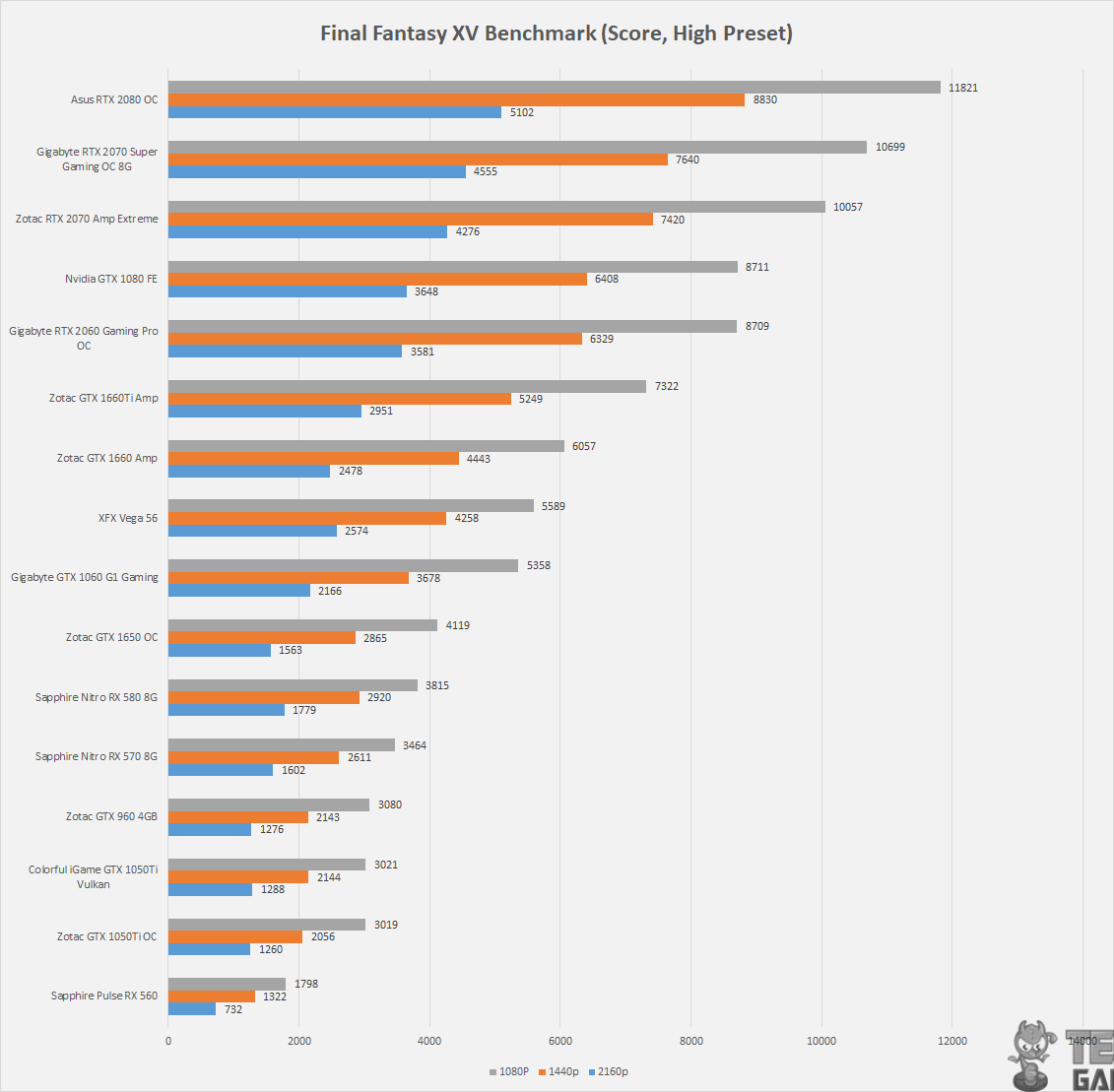
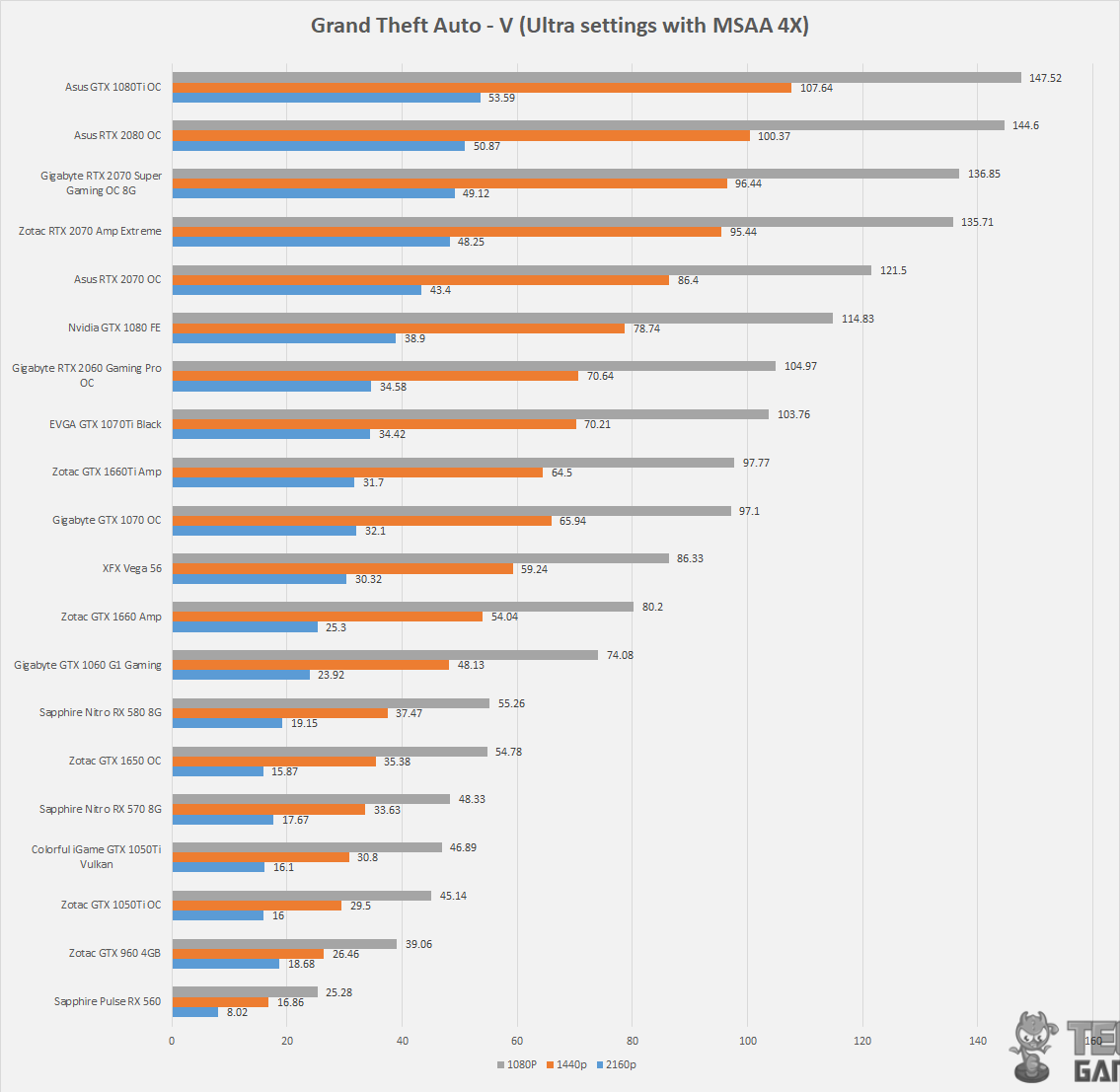
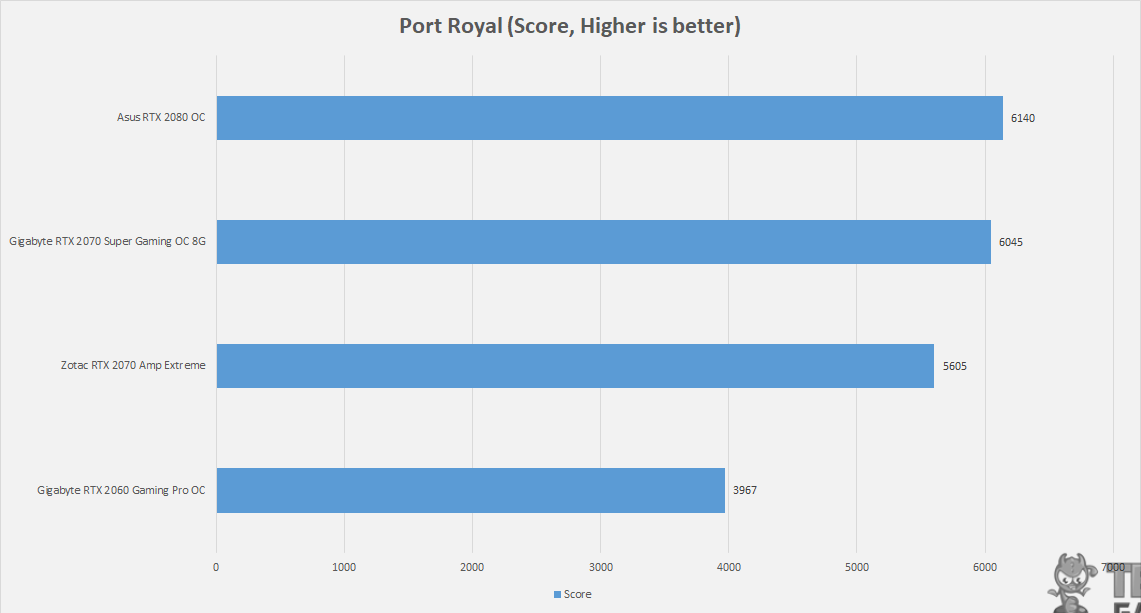
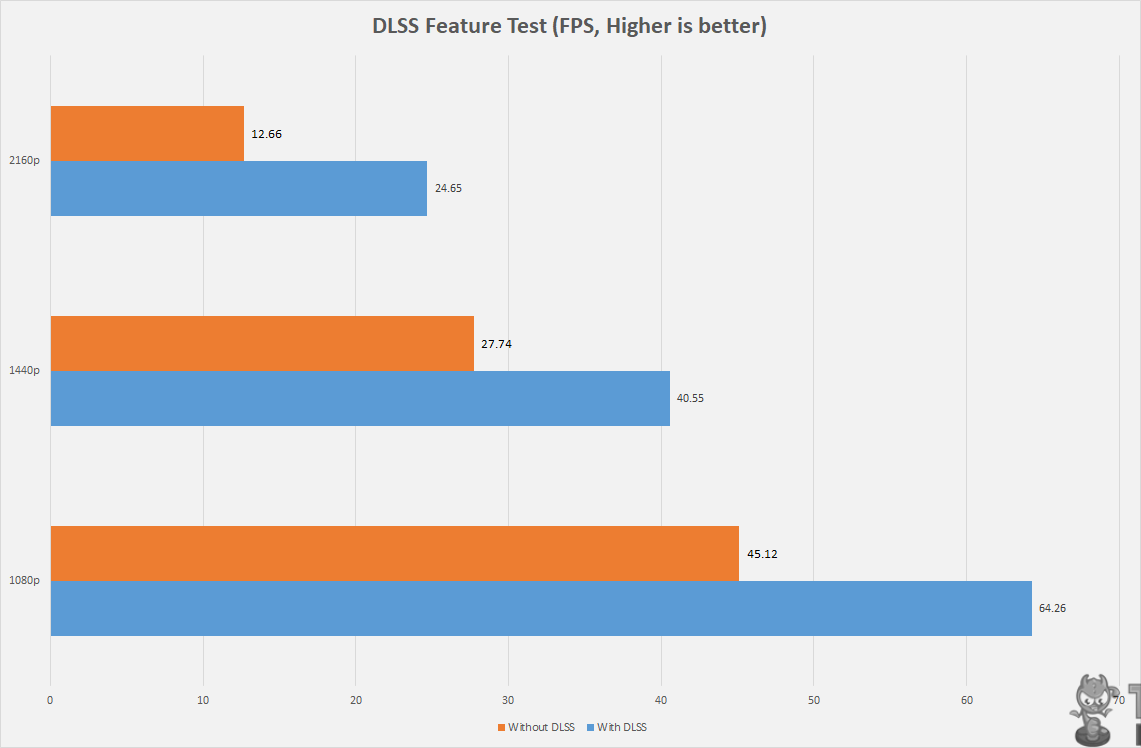
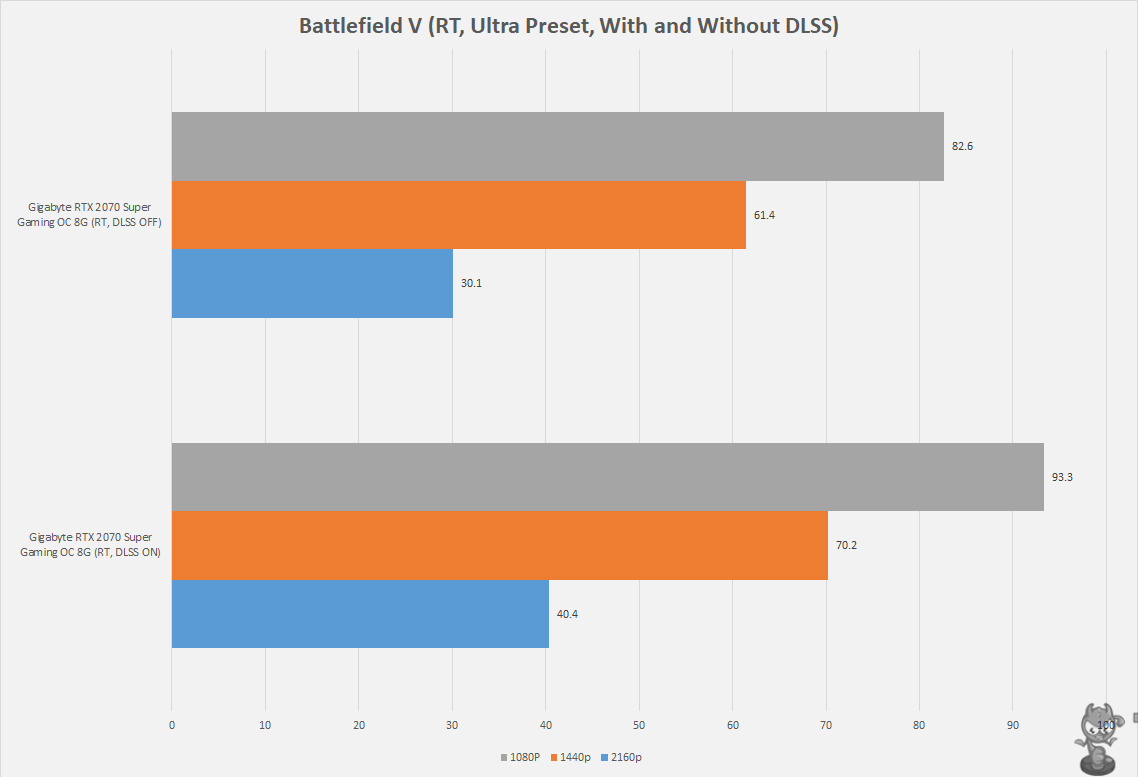
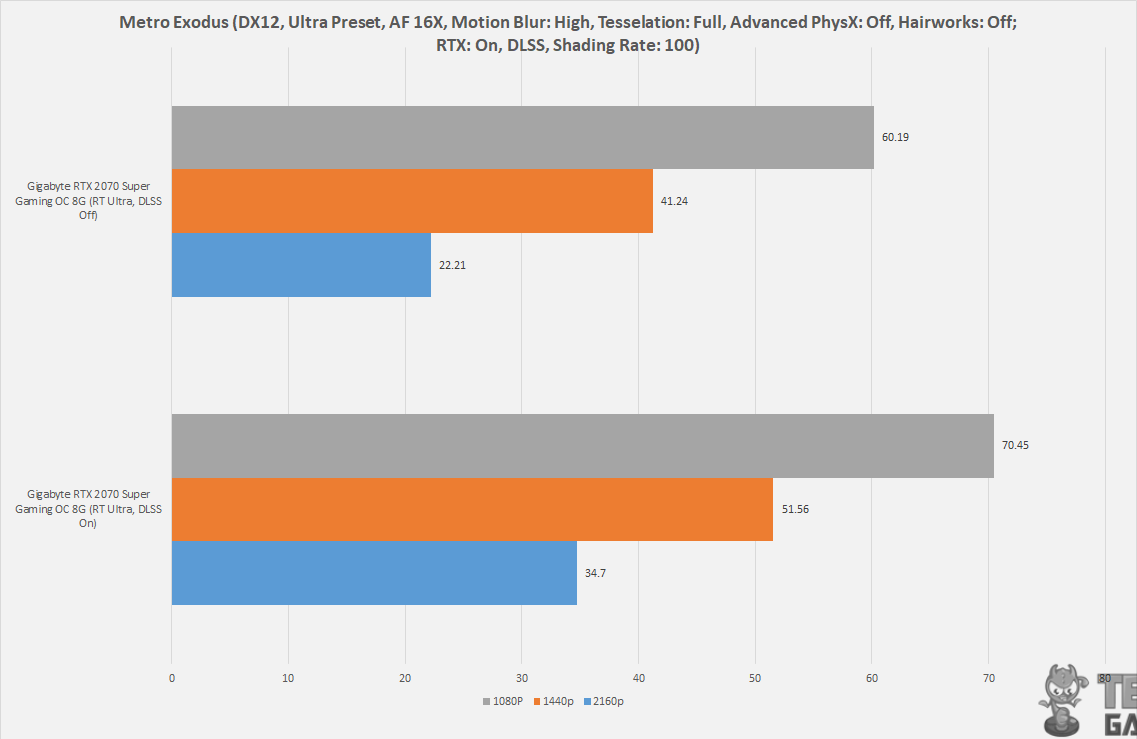
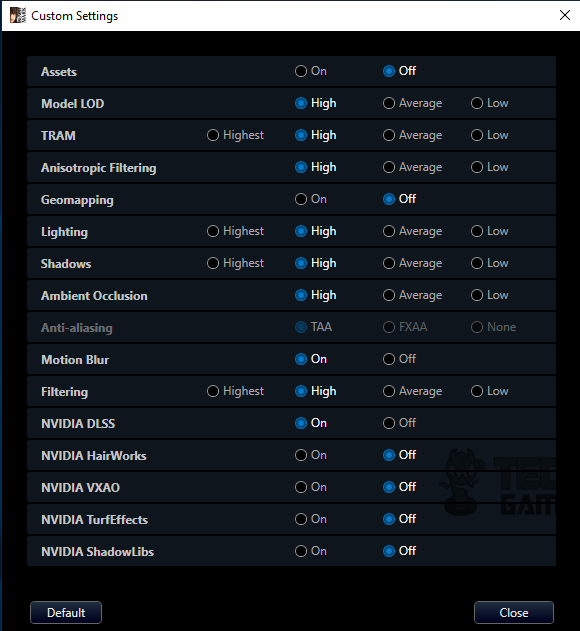
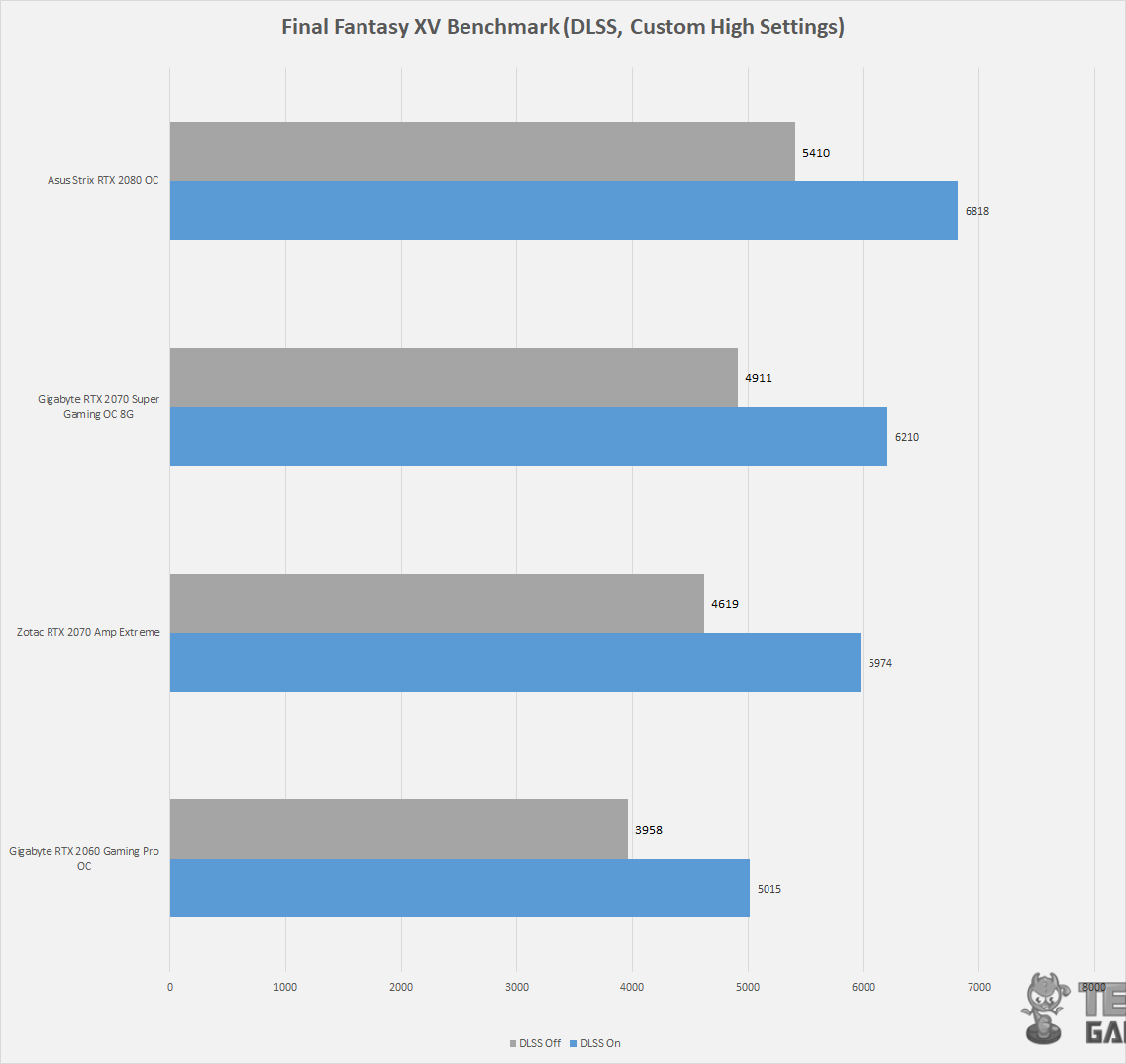
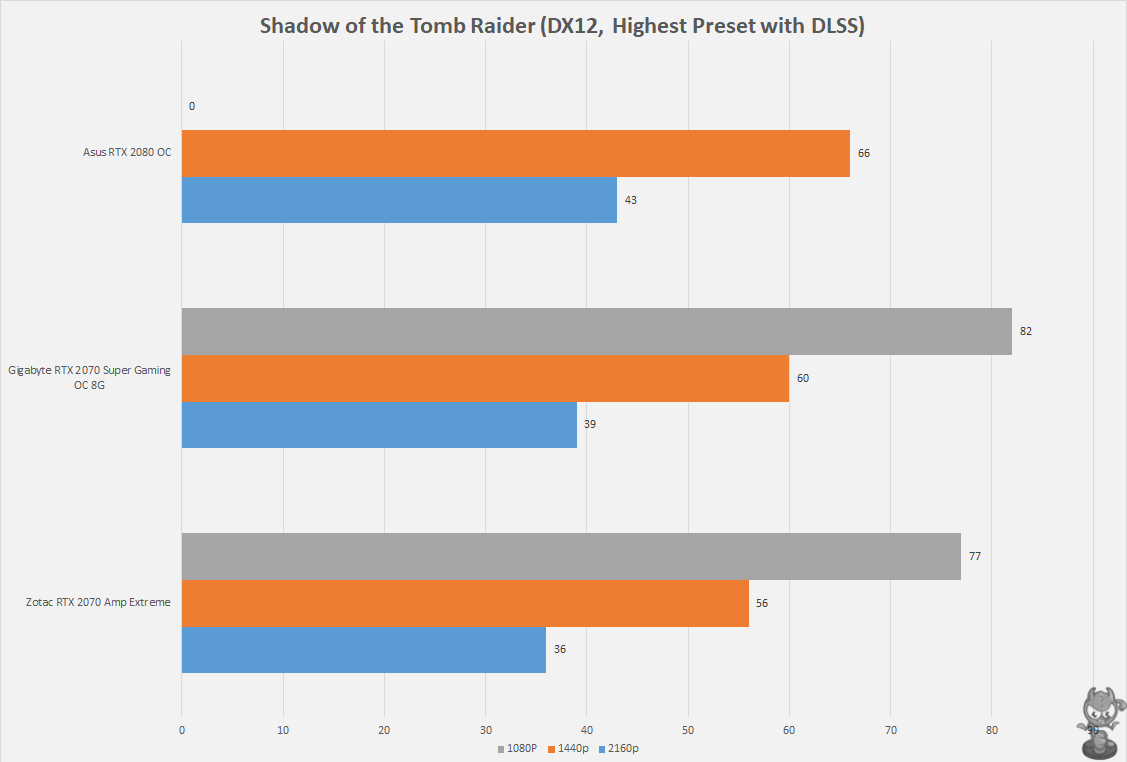
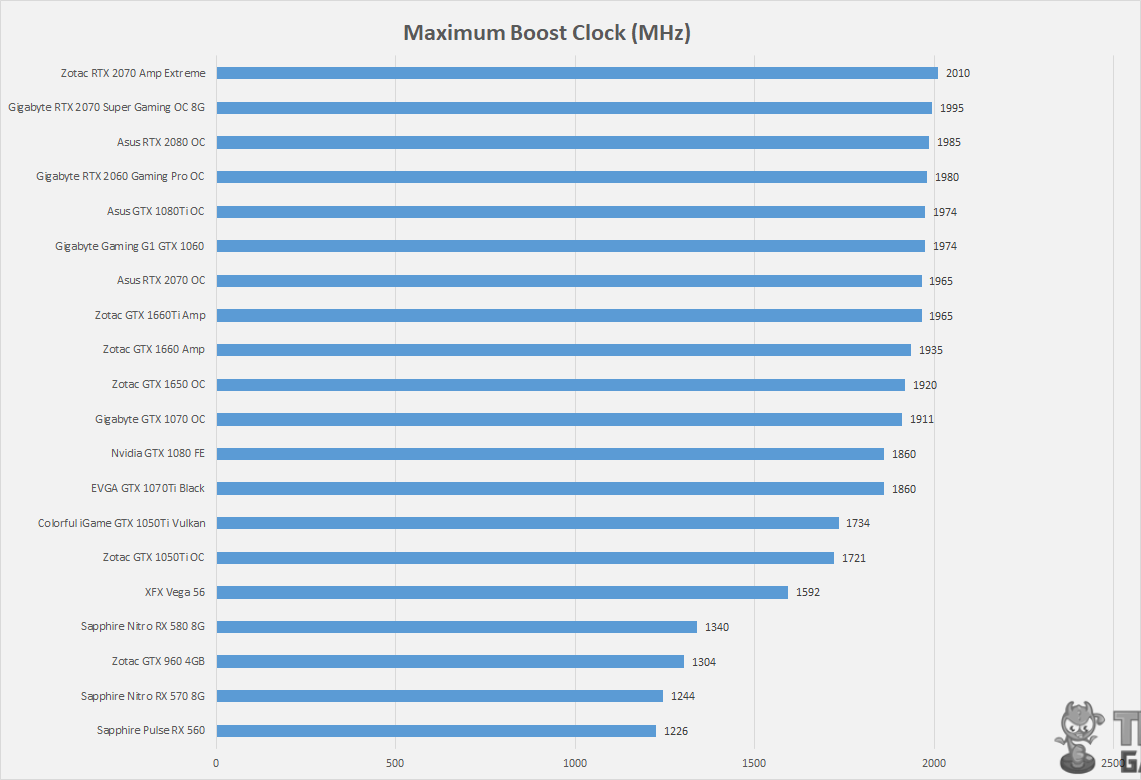
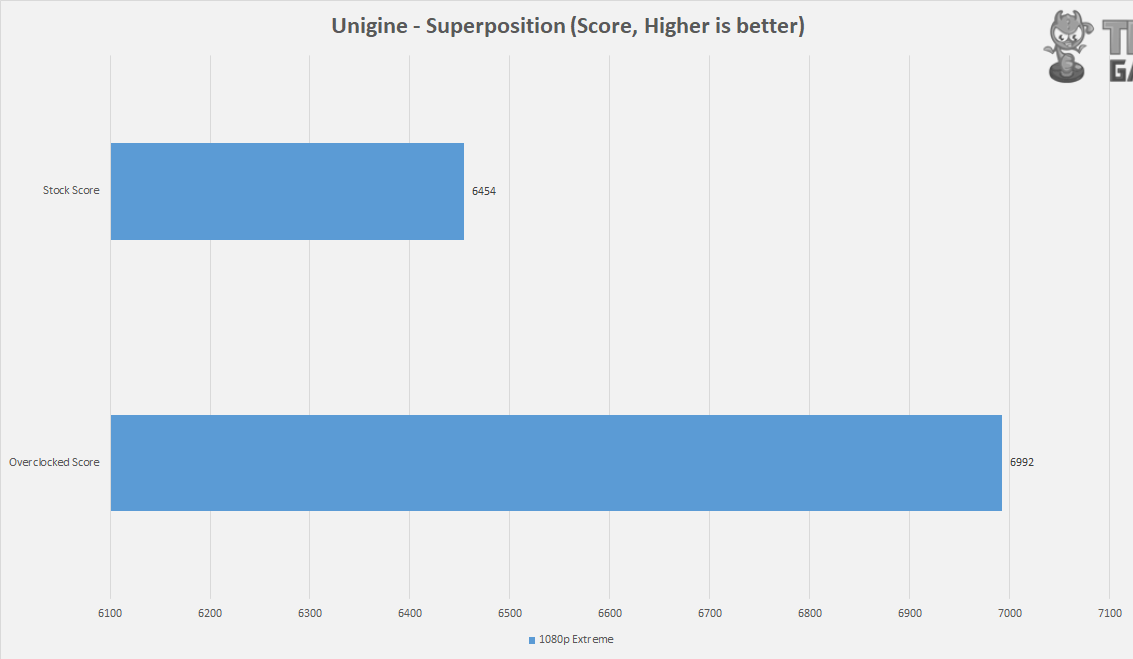

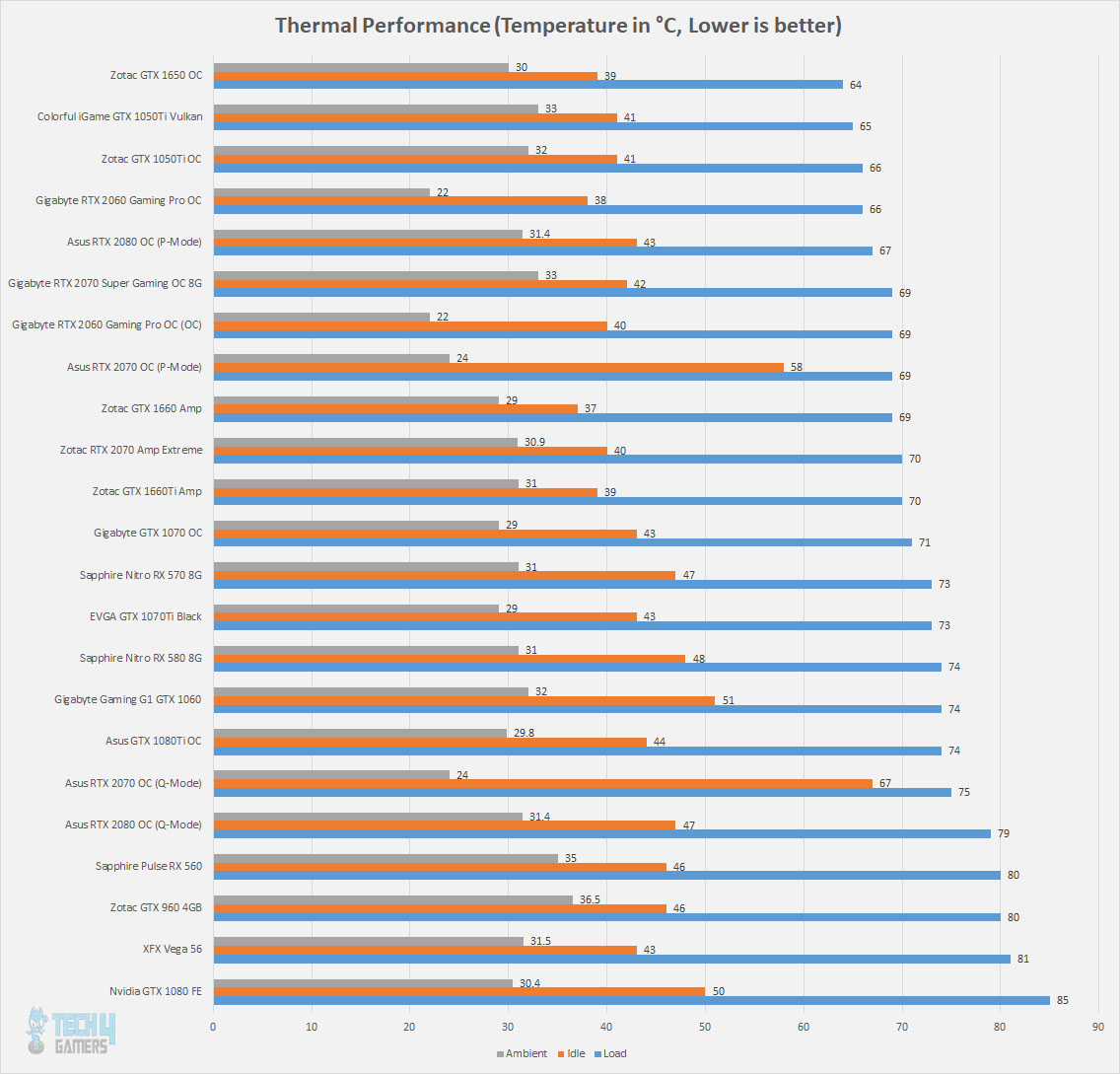








![5 BEST RTX 4060 Ti Graphics Cards [Budget & High-End] Best RTX 4060 Ti Graphics Cards](https://tech4gamers.com/wp-content/uploads/2023/06/Best-RTX-4060-Ti-Graphics-Cards.jpg)
![5 BEST RTX 4060 Graphics Cards [Dec 2023] Best RTX 4060 Graphics Cards](https://tech4gamers.com/wp-content/uploads/2023/07/Best-RTX-4060-Graphics-Cards-.jpg)
![BEST RX 7800 XT Graphics Cards [November 2023] Best RX 7800 XT Graphics Cards](https://tech4gamers.com/wp-content/uploads/2023/09/Best-RX-7800-XT-Graphics-Cards-218x150.jpg)
![6 BEST RTX 4080 Graphics Cards [Nov 2023] Best RTX 4080](https://tech4gamers.com/wp-content/uploads/2022/11/Best-RTX-4080-218x150.jpg)
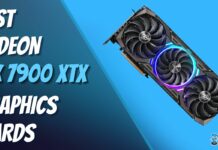
![6 BEST RTX 3080 Graphics Cards [2023 Updated] Best RTX 3080 Graphics Cards](https://tech4gamers.com/wp-content/uploads/2022/07/Best-RTX-3080-1-218x150.jpg)
![Expert Picks: BEST RTX 4090 Graphics Cards [Nov 2023] BEST RTX 4090](https://tech4gamers.com/wp-content/uploads/2022/11/BEST-RTX-4090--218x150.jpg)
![Best GPU For i9-13900K In 2023 [High-Performance & Value] Best GPU For i9-13900K](https://tech4gamers.com/wp-content/uploads/2023/07/Best-GPU-For-i9-13900K-218x150.jpg)
![Best RTX 3060 Ti Graphics Cards In 2023 [Top Rated Picks] Best RTX 3060 Ti](https://tech4gamers.com/wp-content/uploads/2022/07/Best-RTX-3060-Ti-218x150.jpg)
![BEST RTX 3060 Graphics Cards [Expert Picks 2023] Best RTX 3060](https://tech4gamers.com/wp-content/uploads/2022/07/BEST-RTX-3060-218x150.jpg)

![BEST GPU For Core i7-14700K [Top Rated] Best GPU For i7-14700K](https://tech4gamers.com/wp-content/uploads/2023/10/Best-GPU-For-i7-14700K-218x150.jpg)
![The Best GPU For Core i5-14600K [Tested] Best GPU For i5-14600K](https://tech4gamers.com/wp-content/uploads/2023/10/Best-GPU-For-i5-14600K-218x150.jpg)


